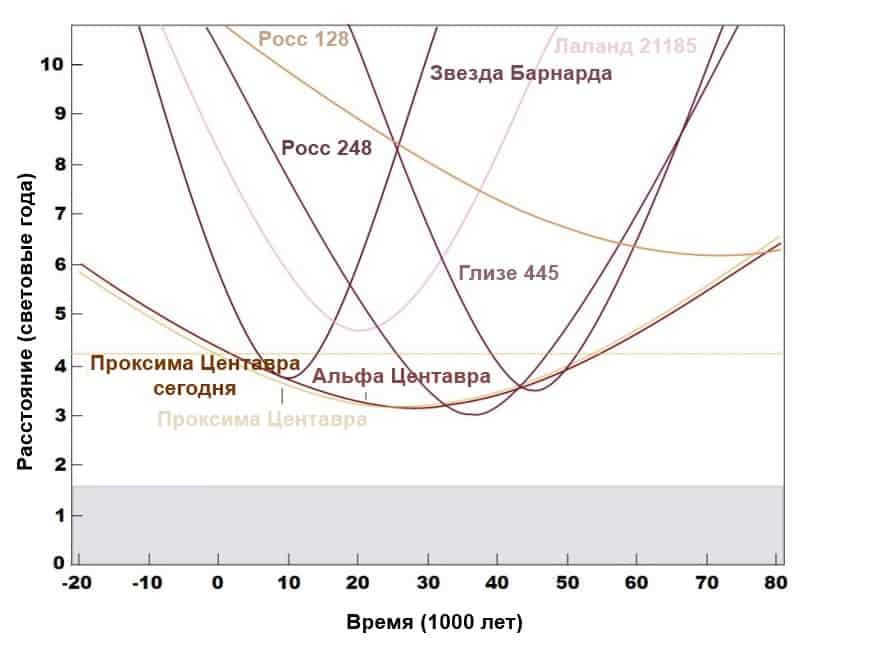
The luminosity of a celestial object or any astronomical entity in outer space is gauged by its apparent magnitude as observed from the Earth. The object’s apparent magnitude is determined by factors such as its distance from the Earth, its intrinsic brightness, and any potential obstructions (primarily interstellar dust) along the line of sight to the star.
There exists an inverse relationship between the brightness of a star and its magnitude; in other words, the brighter a star is, the lower its apparent magnitude will be. The Sun has an apparent magnitude of -26.74.
One other way to gauge the brightness of stars is called absolute magnitude. It quantifies the brightness of a celestial object as seen from a set distance of 32.6 light-years or 10 parsecs. Here is a compilation of the most luminous stars in proximity to our planet, determined by their apparent magnitude (excluding the Sun).
15. Antares
Antares, also known as Alpha Scorpii, is a bright star in the constellation Scorpius. It is one of the largest and most luminous stars known, with a diameter estimated to be around 883 times that of the Sun. The name Antares comes from the Greek term meaning “like Mars,” as the star has a reddish appearance similar to the planet Mars. Antares is located approximately 550 light-years away from Earth and is classified as a supergiant star. It is easily visible in the night sky and is often used as a reference point for astronomers. Despite its great size and brightness, Antares is relatively young, with an estimated age of only 12 million years. Scientists believe that Antares will eventually explode in a supernova event, although it is unclear when this will happen. When it does occur, Antares will likely become one of the brightest objects in the night sky.
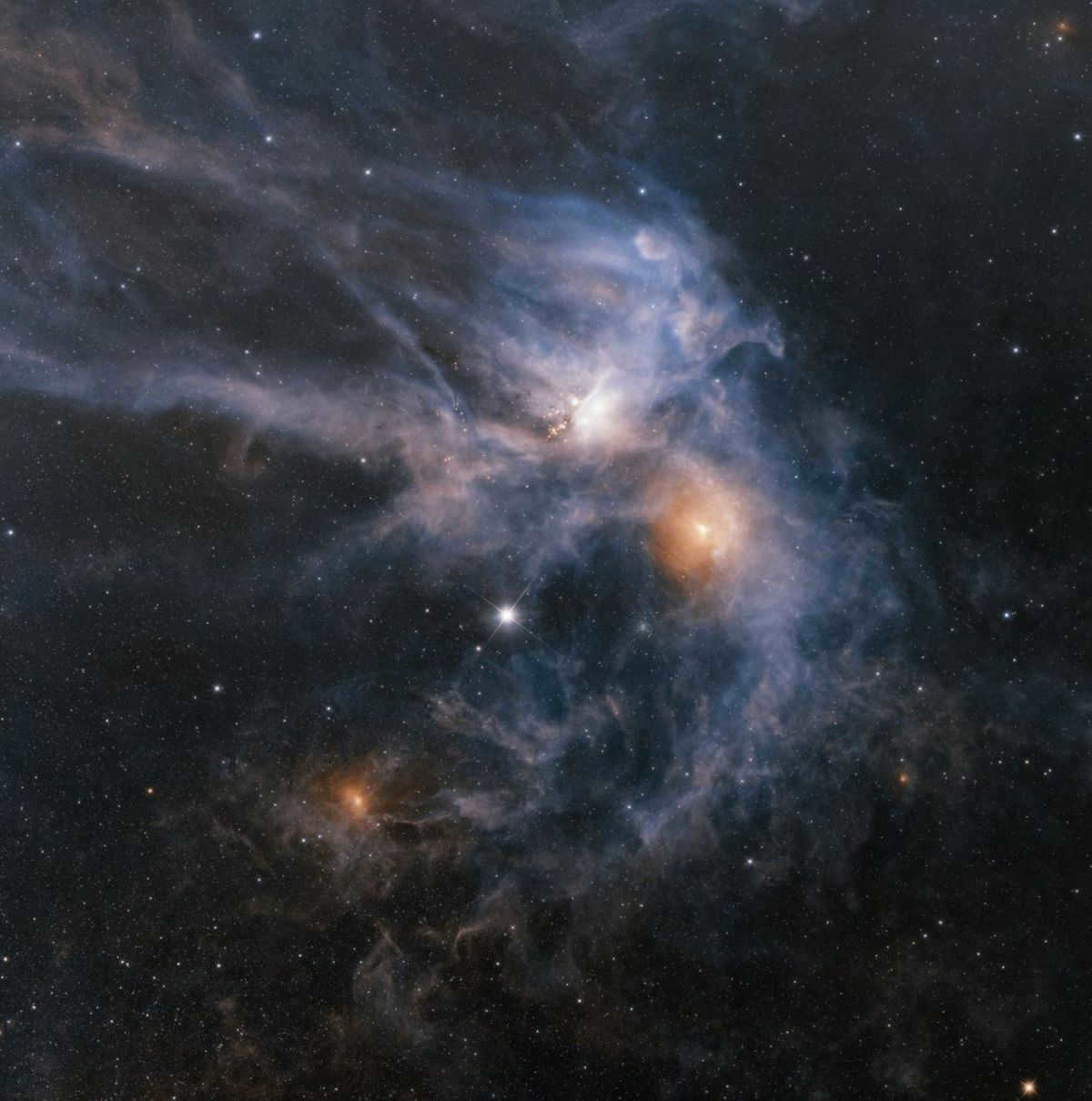
Distance from Earth: Approximately 550 light-years away.
Apparent magnitude: Ranging from 0.6 to 1.6.
Current stage of evolution: Classified as a red supergiant.
Antares, also known as Alpha Scorpio, stands out as the most brilliant star in the Scorpius constellation. Its brightness can vary, with an apparent magnitude that typically falls between +0.6 and +1.6. This behavior is characteristic of a slow and irregular variable star. Antares is not only one of the largest stars, but also one of the brightest stars visible to the naked eye in the night sky.
Although Antares appears as a single star, it is actually a binary system consisting of two stars: Antares and Antares B. The smaller component, Antares B, is a blue main-sequence star.
14. Aldebaran
Aldebaran, also known as Alpha Tauri, is a bright orange giant star located in the constellation Taurus. It is the brightest star in the constellation and is easily visible to the naked eye. Aldebaran is approximately 65 light-years away from Earth.
This star has a diameter that is about 44 times larger than the Sun and a mass that is about 1.7 times greater. It is classified as a K5III spectral type, which means it is a cool giant star nearing the end of its life cycle. Aldebaran is also a variable star, meaning its brightness fluctuates slightly over time.
In ancient mythology, Aldebaran was often associated with the eye of the bull in the constellation Taurus. It has been mentioned in various cultures and has different names in different languages. Aldebaran is also an important star for astronomers, as its properties and characteristics provide valuable insights into the life cycles of stars.
Observing Aldebaran can be an exciting experience for both amateur and professional astronomers. Its distinct orange color and brightness make it a prominent feature in the night sky. By studying Aldebaran and other stars, scientists can continue to expand our understanding of the vast universe in which we live.
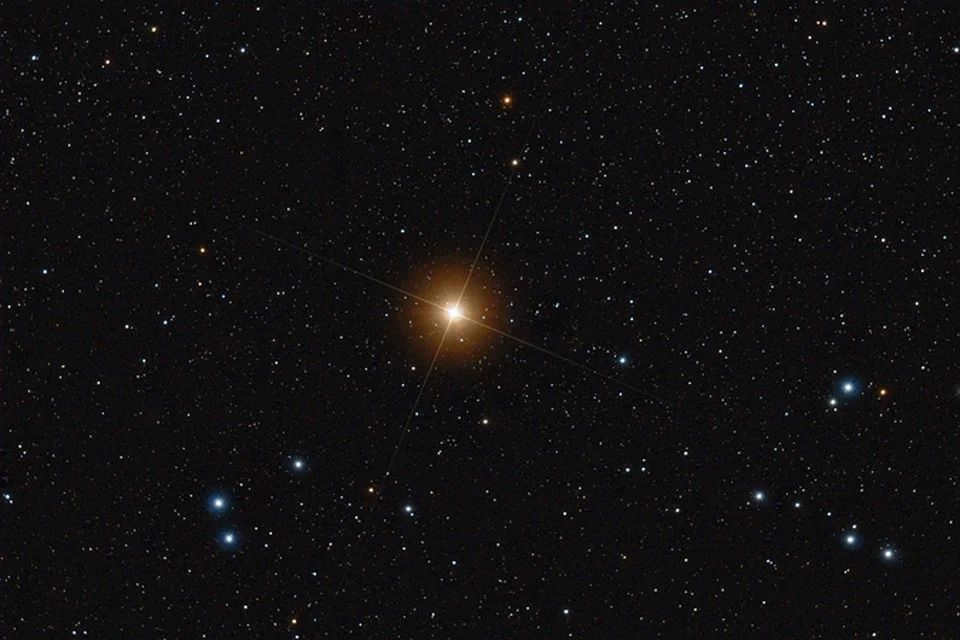
Distance from Earth: Aldebaran is located 65.3 light-years away from Earth.
Visible magnitude: Its visible magnitude is +0.86.
Current stage of evolution: Currently, Aldebaran is in the Red Giant phase.
Aldebaran, also known as Alpha Taurus, is the brightest star in the Taurus constellation. It is classified as a red giant with a spectral class K, which means it has transitioned from the main-sequence phase after depleting hydrogen in its core.
Based on the current stellar evolution model, Aldebaran has a luminosity approximately 425 times that of the Sun, despite being only 50 percent more massive.
Pioneer 10, one of NASA’s oldest and most distant space probes, is on a trajectory towards Aldebaran and is expected to reach it in approximately two million years.
13. Akruks
Reword the text, making it unique, using the English language and preserving the HTML markup:
13. Akruks
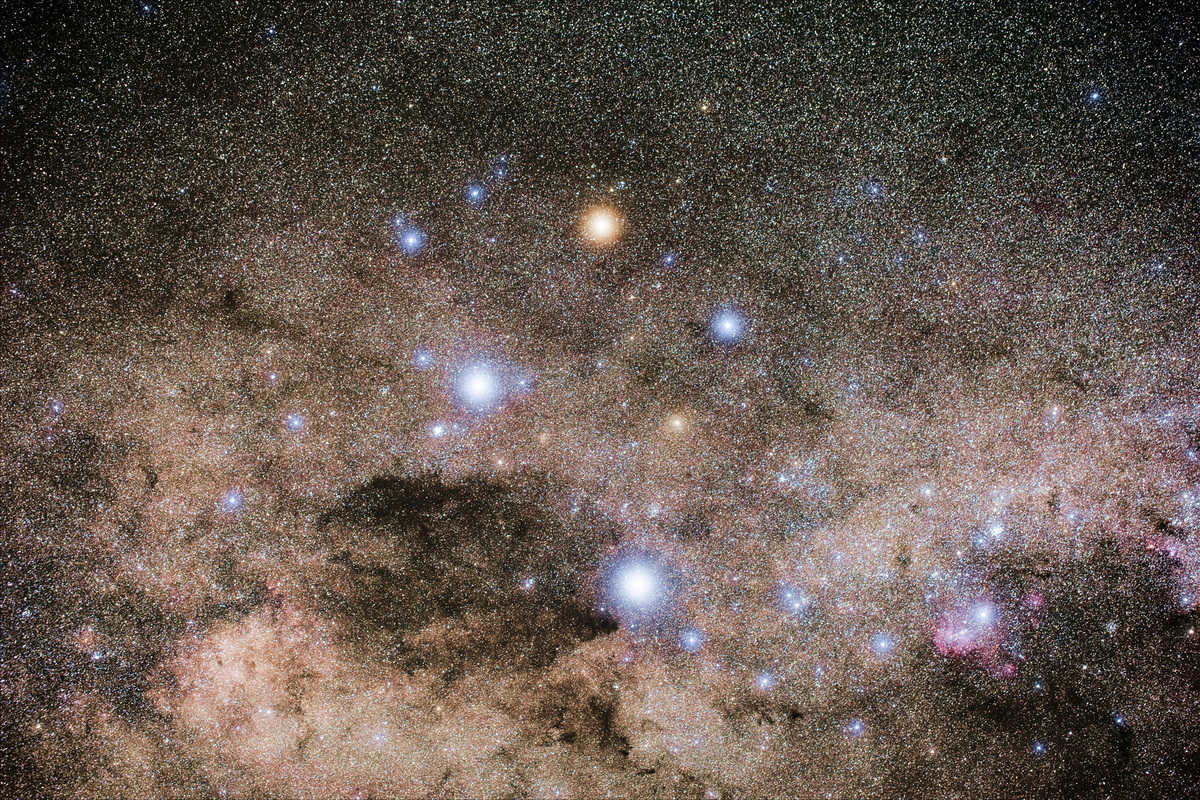
Distance from Earth: 320 light-years.
Visible magnitude: +0.76.
Akruks, also known as Alpha of the Southern Cross, is a system of stars located in the Southern Cross constellation, situated approximately 320 light-years away. The Acrux system consists of a minimum of five distinct stars. The primary two components, Acrux A and Acrux B, form a closely orbiting binary system. These two stars are accompanied by the more distant Acrux C, and collectively they create a triple star system. Both Acrux A and Acrux B are themselves double stars.
With a combined visual magnitude of 0.76, Akruks is the most luminous star in the Southern Cross constellation and the 13th brightest star in the night sky. Acrux is the southernmost first magnitude star and can only be observed south of 27° north latitude.
12. The Altair
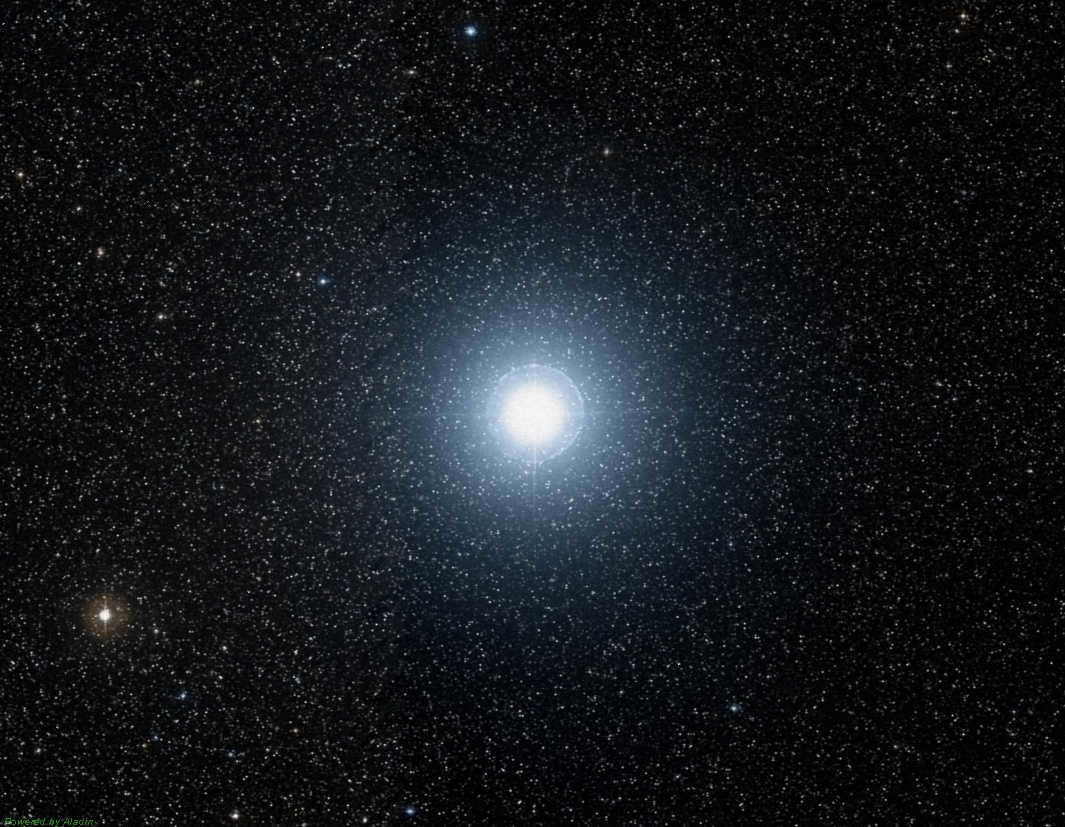
Earth Distance: 16.73 light-years.
Magnitude: +0.76.
Evolution Stage: A-type main-sequence star.
Altair is the most brilliant star in the constellation of the Eagle and one of the nearest stars to Earth that can be seen with the naked eye. This star is approximately 1.8 times more massive than the Sun and emits 11 times more light (luminosity).
Together with Vega and Deneb, Altair creates the Summer Triangle, a fictional triangle that links stars from three different constellations: the Eagle, Lyra, and Swan, respectively.
Interferometric research has revealed that the star possesses flattened poles as a result of its high rate of rotation.
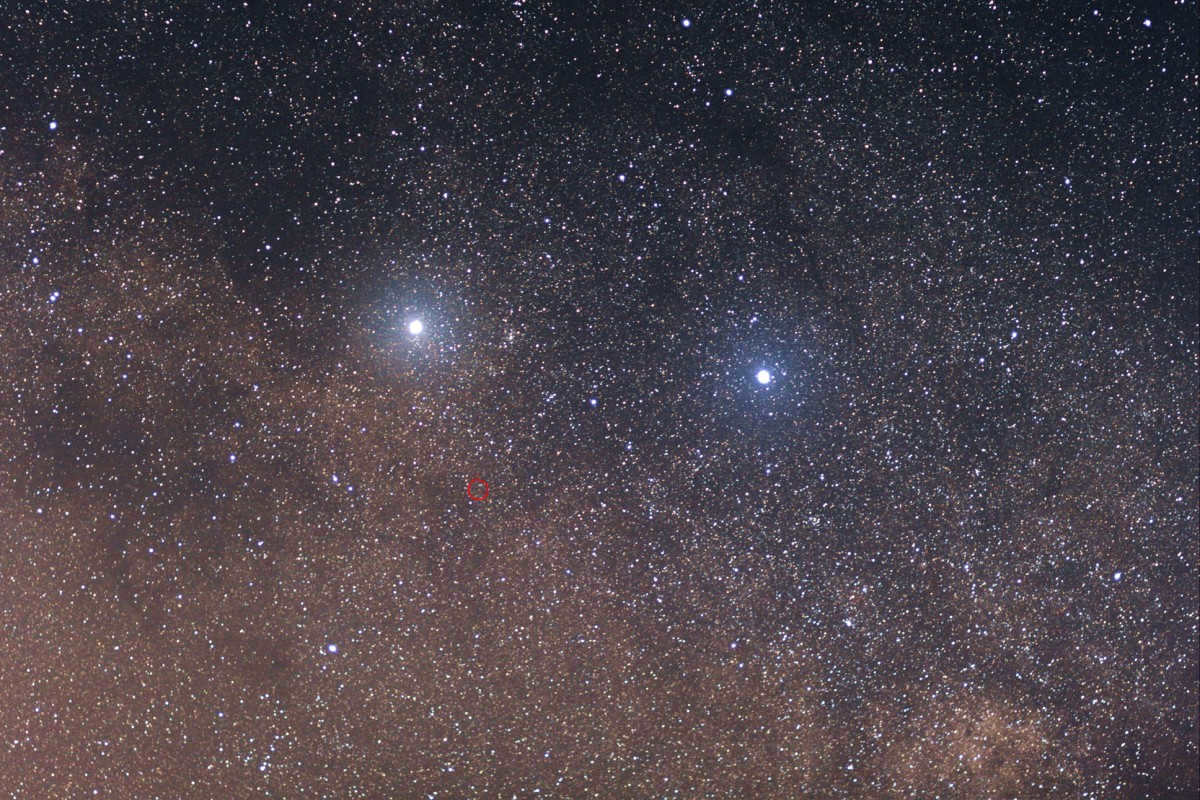
Distance from Earth: Beta Centauri is located approximately 390 light-years away from Earth.
Visible magnitude: Its visible magnitude is +0.61.
Beta Centauri, also known as Hadar, stands out as the eleventh brightest star in the night sky. This star is actually a triple star system, composed of three stars: Beta Centauri Aa, Beta Centauri Ab, and Beta Centauri B. Both Aa and Ab are over ten times more massive than our Sun.
With a combined visual magnitude of +0.61, Beta Centauri holds the distinction of being the second brightest star in the Centauri constellation, following our nearby neighbor, Alpha Centauri.
Moreover, Beta Centauri is categorized as a variable Beta Cephei due to its rapid fluctuations in brightness. However, these changes are relatively minor and cannot be detected with the naked eye.
10. Betelgeuse
Betelgeuse, also known as Alpha Orionis, is a red supergiant star in the constellation Orion. It is one of the largest known stars and is located approximately 640 light-years away from Earth.
Betelgeuse is easily visible to the naked eye and is known for its red coloration. It is classified as a variable star, meaning its brightness fluctuates over time. In recent years, Betelgeuse has attracted attention due to its noticeable dimming, leading to speculation about its potential supernova explosion.
Despite its distance, Betelgeuse is a relatively young star, estimated to be only about 8 million years old. It is nearing the end of its life cycle and is expected to explode as a supernova within the next million years. When this happens, Betelgeuse will briefly become one of the brightest objects in the night sky.
Scientists are closely monitoring Betelgeuse to better understand the life cycle of massive stars and the processes that occur during supernova explosions. Its close proximity and brightness make it an ideal candidate for study.
In addition to its scientific significance, Betelgeuse also holds cultural significance. It is named after the Arabic phrase “Yad al-Jauza,” which means “the hand of Orion.” In mythology, Orion was a hunter who was killed by a scorpion, and Betelgeuse represents the hunter’s hand.
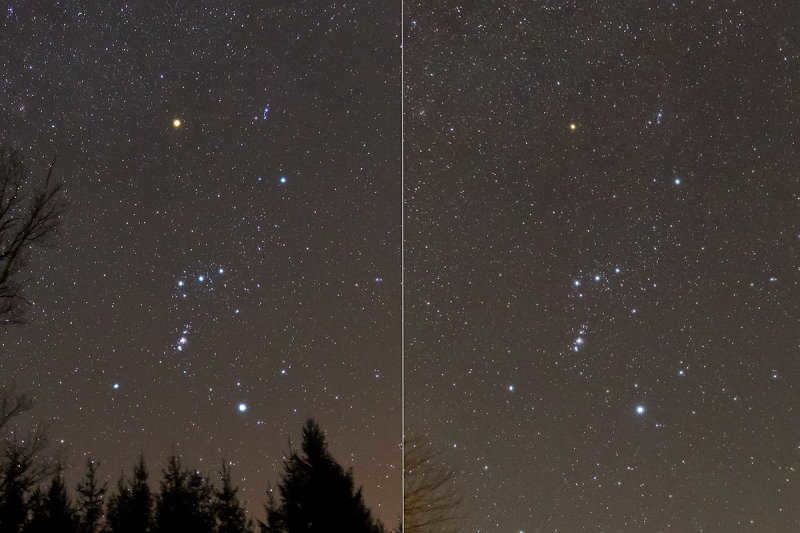
Earth Distance: 727 light-years.
Visible Brightness: +0.50.
Current Evolution Stage: Red supergiant.
Betelgeuse, also known as Alpha Orionis, is the second most luminous star in the constellation Orion. It is a star that varies in brightness, with a magnitude range of 0.3 to +1.8, and it is the largest star of its kind in terms of magnitude.
The changes in brightness of Betelgeuse were initially recorded by Sir John Herschel between 1836 and 1840. During this period, Herschel observed significant fluctuations in the star’s brightness, with it sometimes being much larger than the typically brighter Rigel star.
According to the American Association of Variable Star Observers, Betelgeuse had a minimum observed magnitude of 1.2 between 1927 and 1941.
According to current estimations, Betelgeuse’s mass is believed to range from 10 to slightly over 20 times the mass of our Sun. This celestial body is considered to be one of the most massive stars that can be seen without the aid of any telescope.
9. Ahernar
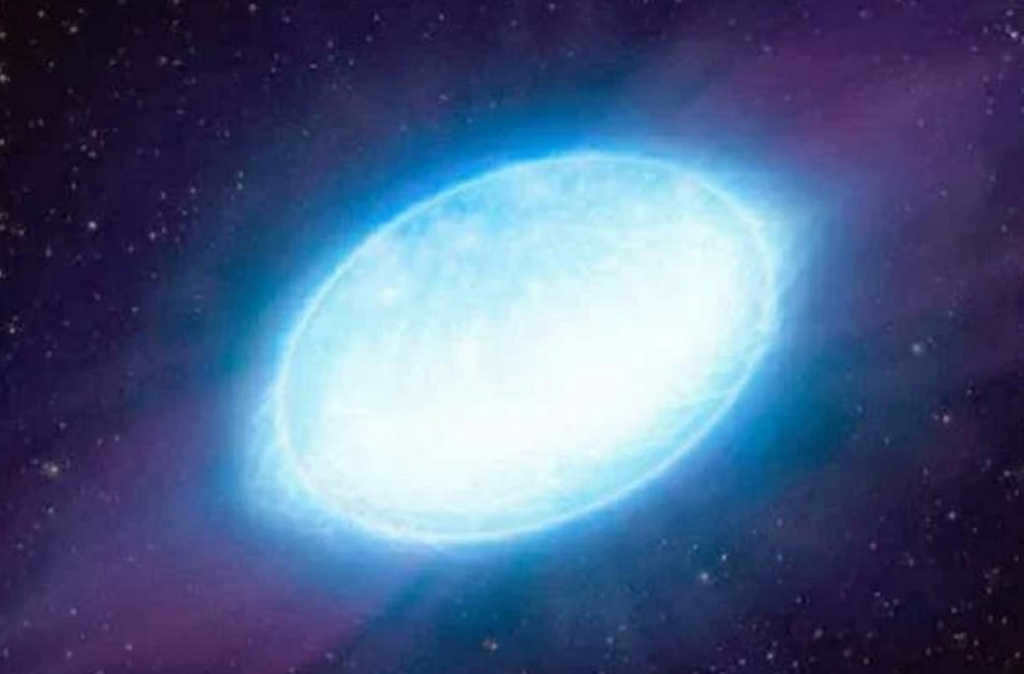
Distance from Earth: 139 light-years.
Visible magnitude: +0.46.
Ahernar, also known as Alpha Eridana, is a binary star system situated in the Eridanus constellation. The two constituents of the star system are Alpha Eridana A and B. The more luminous of the two, Eridana A, is categorized as a B-type main-sequence star, one of the most brilliant of all recognized star types.
The star is approximately 3150 times more luminous than the Sun and seven times more massive. Ahernar is most effectively observed from the southern hemisphere at a latitude of 33 degrees south, while it becomes imperceptible above a latitude of 33 degrees north.
8. Procyon
Procyon is a star system located approximately 11.4 light-years away from Earth in the constellation of Canis Minor. It is the eighth closest known star system to the Sun and is easily visible in the night sky. Procyon is a binary star system, meaning it consists of two stars orbiting around a common center of mass. The larger star, Procyon A, is a white-yellow main-sequence star, while the smaller star, Procyon B, is a white dwarf. Procyon is one of the brightest stars in the sky and has a magnitude of 0.34, making it the seventh brightest star visible from Earth. It is also one of the closest star systems that can be seen with the naked eye.
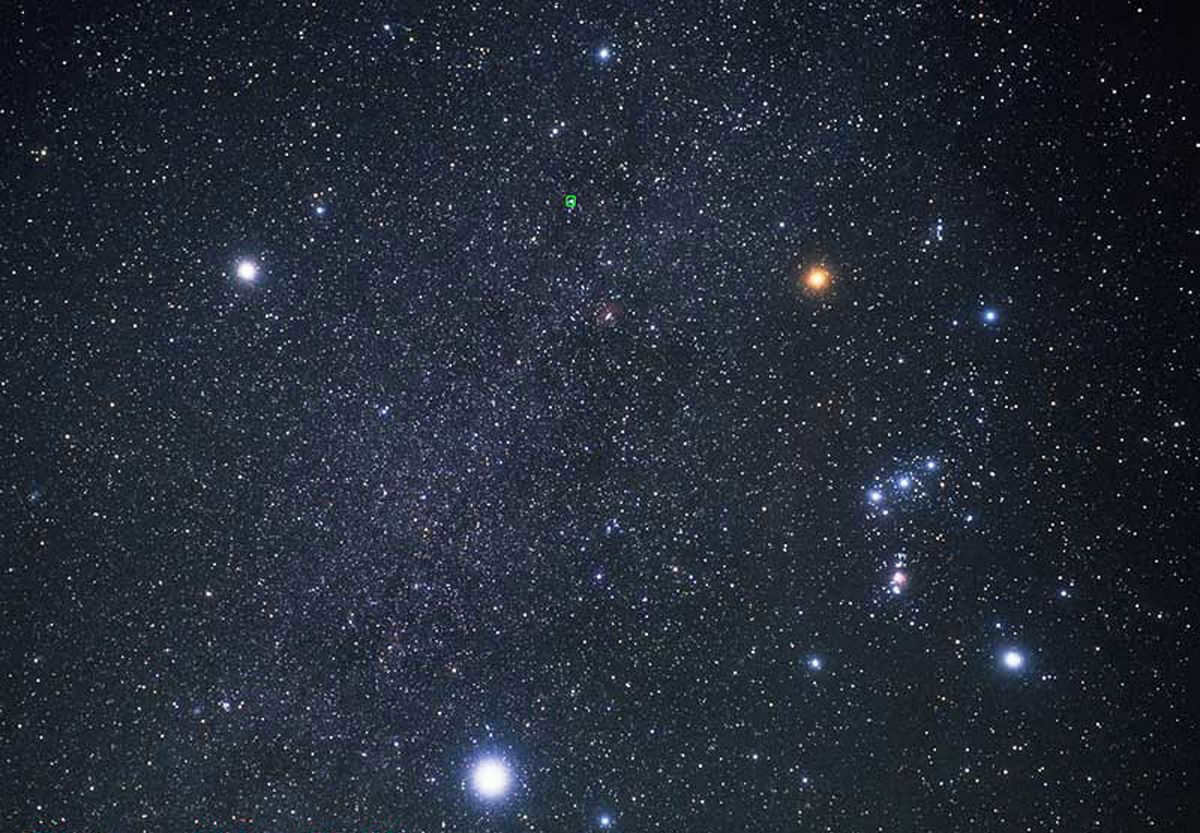
Distance from Earth: 11.46 light-years.
Visible magnitude: +0.34.
Procyon, also known as the Alpha Canis Minoris, is the most brilliant star in the constellation Canis Minor and the eighth most brilliant star in the nocturnal sky. Procyon is actually a binary star system, comprised of a main-sequence star (Procyon A) and a white dwarf (Procyon B).
Procyon A has an estimated atmospheric temperature of approximately 6,530 K, and its luminosity is approximately seven times that of the Sun. Alongside Sirius and Betelgeuse, Procyon forms the asterism known as the Winter Triangle.
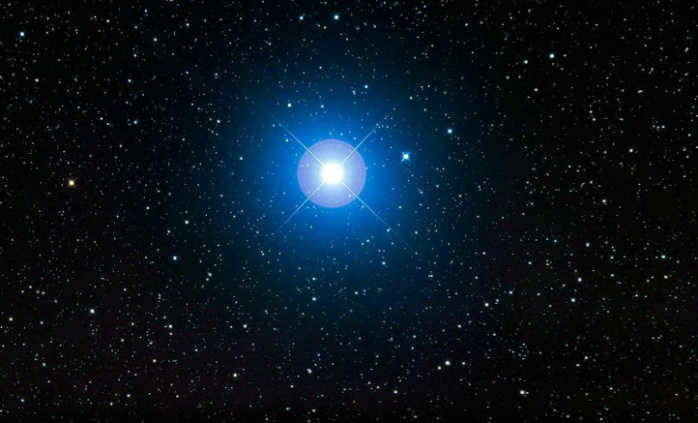
Distance from Earth: Rigel is located approximately 860 light-years away from Earth.
Visible magnitude: Rigel has a visible magnitude of 0.13.
Current stage of evolution: Rigel is currently in the blue supergiant stage of evolution.
Rigel, situated in the constellation Orion, stands out as the brightest star in the night sky. Despite its appearance as a single star, Rigel is actually a complex system consisting of at least four stars. The main star in the group, known as Rigel A, shines 120,000 times brighter than our Sun and boasts a mass 21 times greater (although these values may vary depending on the measurement method). Other components of the system include Rigel Ba and Bb (a double star system observed through spectroscopy) as well as the more distant Rigel C.
Rigel falls under the classification of an Alpha Swan variable, which is a group of variable stars that display both contraction and expansion on different parts of their surface. The brightness, or apparent magnitude, of Rigel ranges from 0.05 to 0.18.
While Rigel typically holds the title of being the most luminous star in the Orion constellation, it has been known to be surpassed by the red supergiant Betelgeuse on certain occasions.
6. Capella Aa / Ab
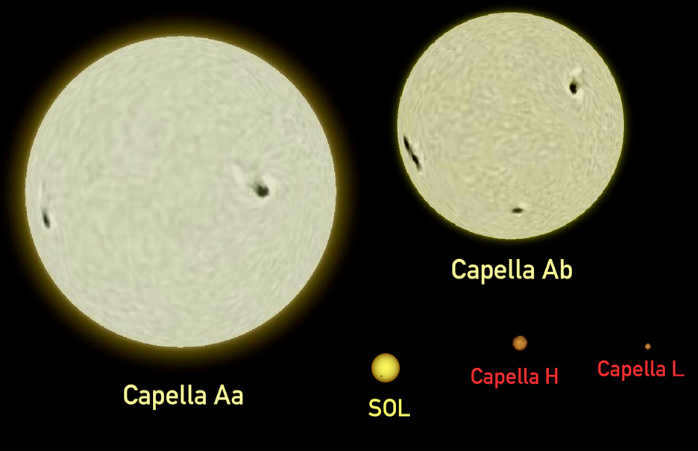
Earth’s distance: 42.9 light-years.
Visible brightness: +0.08.
Present stage of evolution: Red giant, main sequence.
Following Arcturus and Vega, Capella is the third most luminous star in the northern celestial hemisphere and the brightest one in the constellation of Ascendant. Instead of being a single star, Capella is a multiple star system that consists of four stars arranged in pairs of two.
The most prominent star among the four is Capella Aa, which is a red giant with a mass 2.5 times that of the Sun, but is almost 79 times brighter. Its twin companion, Capella Ab (a subgiant), is slightly smaller and less bright. The second pair, Capella H and L, are much smaller and fainter than the red dwarfs.
Capella, which is the nearest first magnitude star to the North Pole, can be seen all year round above 44 degrees north latitude. However, it becomes invisible below 44 degrees south latitude.
5. Vega
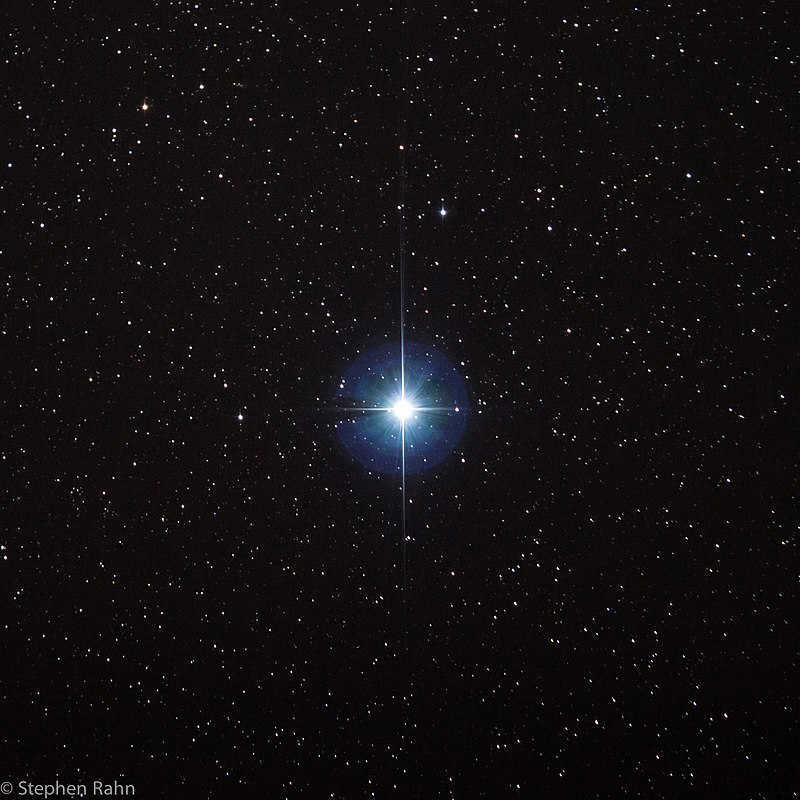
Earth Distance: 25.4 light-years.
Visible magnitude: +0.03.
Evolutionary Stage: Main Sequence.
Vega, also known as Alpha Lyrae, is a well-studied star in close proximity to the Sun. It was one of the first stars to have its distance estimated using stellar parallax shift. The star is also utilized in astrophotography to calibrate photometric brightness.
Vega is the brightest star in the Lyra constellation and the second brightest in the northern hemisphere, following Arcturus. It is estimated to be 2.1 times more massive and 40 times brighter than the Sun. However, both its age and estimated lifespan are considerably shorter than our Sun.
4. Arcturus
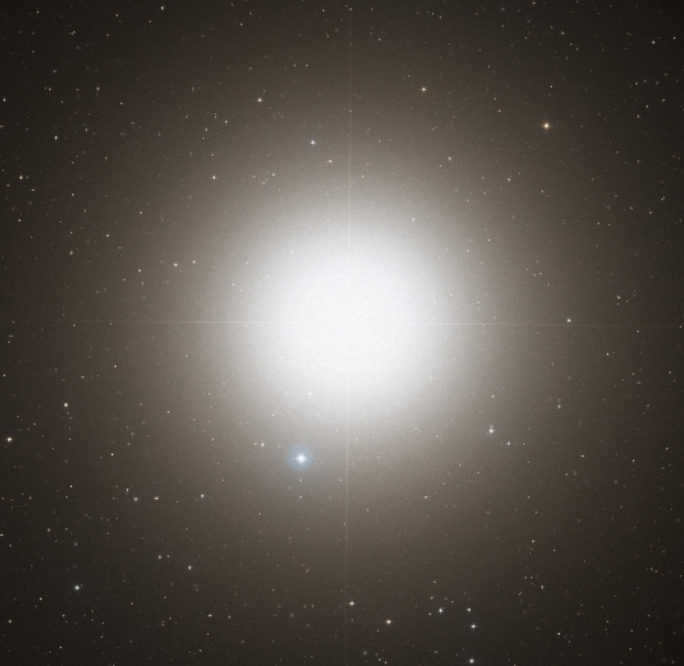
Distance from Earth: 36.7 light years.
Visible magnitude: -0,05.
Arcturus is the dominant star in the Volopassus constellation and the northern celestial hemisphere. It is surpassed in brightness by only three stars in the night sky. Despite being just 0.8 times more massive than the Sun, Arcturus is 25 times larger and 170 times brighter.
In 1635, the French astronomer Jean-Baptiste Morin became the first person to observe Arcturus in a telescope during daylight hours, making it the first star (apart from the Sun and supernovae) to be seen in such conditions.
3. Alpha Centauri A
Alpha Centauri A, also known as Rigil Kentaurus, is the primary component of the Alpha Centauri star system. It is the closest star to Earth outside of the solar system, located about 4.37 light-years away. Alpha Centauri A is a yellow-hued main-sequence star that is slightly larger and brighter than our Sun. It has a mass of about 1.1 times that of the Sun and a radius of approximately 1.2 times that of the Sun. Alpha Centauri A is estimated to be about 6 billion years old and is believed to have a similar composition to our Sun. It is a prime target for future interstellar exploration and potentially habitable exoplanet research.
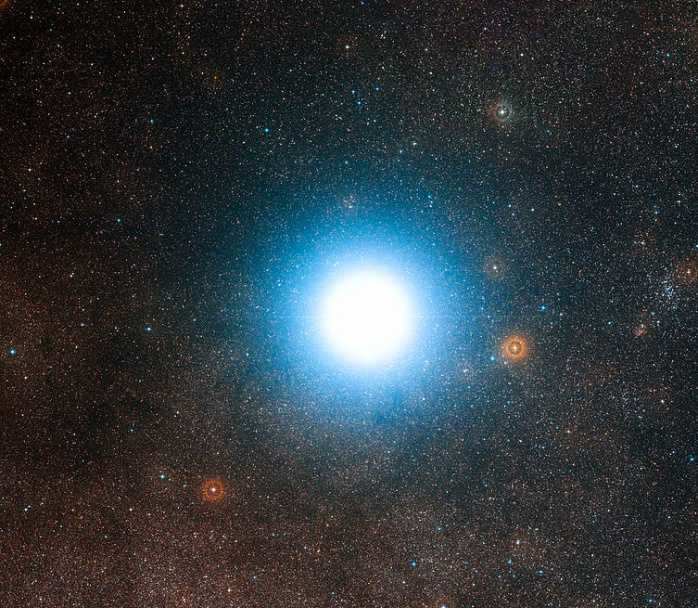
Distance from Earth: 4.37 light-years.
Visible magnitude: -0.27.
Alpha Centauri is a system of multiple stars that consists of two closely located double stars, Alpha Centauri A and Alpha Centauri B, as well as the relatively distant Alpha Centauri C or Proxima Centauri. Despite being the star closest to the Solar System, Proxima Centauri is much dimmer compared to Alpha Centauri AB.
The estimated distance between Proxima Centauri and Alpha Centauri AB is approximately 0.21 light-years (towards the solar system).
The most prominent star among the three, Alpha Centauri A, also referred to as Rigil Centaurus, is slightly more massive and 1.519 times brighter than the Sun. However, its double companion is slightly less massive and twice as bright as a star in our solar system.
2. Canopus
Canopus, also known as Alpha Carinae, is the second brightest star in the night sky. It is located in the constellation Carina and is approximately 310 light-years away from Earth. Canopus is a supergiant star, about 71 times larger than our sun and about 10,000 times brighter. It is a hot star with a surface temperature of about 7,500 Kelvin. Canopus is easily visible from the southern hemisphere and is a prominent star in the constellation Carina. Its name comes from the ancient Greek mythological figure Canopus, who was a navigator for Menelaus, the king of Sparta.
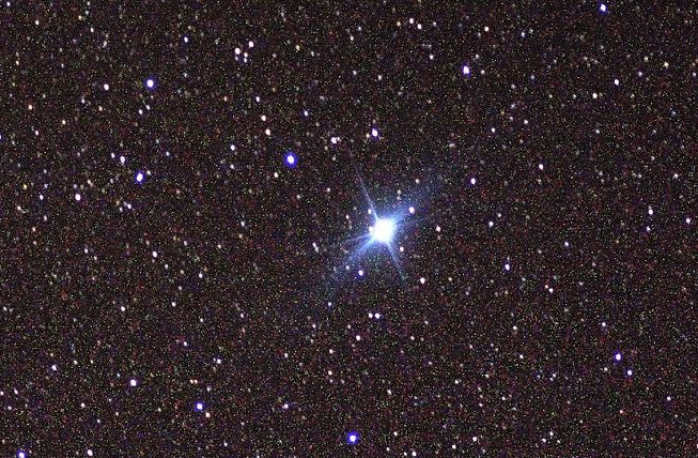
Distance to Earth: 310 light-years.
Visible magnitude: -0.74.
Canopus, also referred to as Alpha Carinae, is the most dazzling star in the Carina constellation and the second brightest in the night sky. In typical circumstances, this brilliant giant A-type star is observable in the southern hemisphere all year round, especially during the summer season.
Canopus is believed to possess a luminosity that is 10,700 times greater than that of the Sun, while also being approximately eight times more massive. Prior to the launch of the Hipparcos satellite in 1989, the estimated distance between the Sun and Canopus ranged from 90 to 1200 light-years.
1. Sirius
Sirius is the brightest star in the night sky and is also known as the Dog Star. It is located in the constellation Canis Major and is approximately 8.6 light-years away from Earth. Sirius is a binary star system, meaning it consists of two stars orbiting around a common center of mass. The primary star, Sirius A, is a white main-sequence star, while the secondary star, Sirius B, is a white dwarf. Sirius is easily visible from Earth and has been observed by astronomers for centuries. It has a significant cultural and historical significance in many civilizations, including ancient Egypt, where it was associated with the flooding of the Nile River. Today, Sirius is studied by astronomers to gain a better understanding of stellar evolution and to search for potential exoplanets in its system.
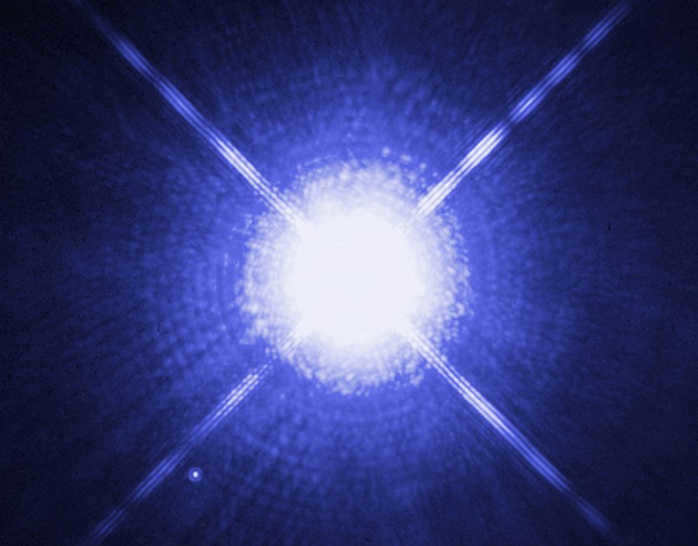
Earth’s Distance: 8.6 light-years.
Visible brightness: -1.47.
Sirius, the most shining star in the nocturnal sky and the second most brilliant one after the Sun (it can also be spotted during the daytime). It is a binary star, comprising of a main-sequence star (Sirius A) and a white dwarf (Sirius B).
Sirius A is more than twice as massive as the Sun, and its brightness is 25 times stronger. Its absolute brightness is +1.42. Its companion, Sirius B, is significantly less massive and luminous.
Although Sirius is surprisingly less bright than Canopus and even Rigel, it appears much more radiant due to its distance from the Earth (intrinsic brightness).
Sirius holds immense mythological importance. In ancient Greek lore, Sirius was regarded with apprehension, as it was believed to be the harbinger of scorching summers, seen as a retribution for humanity. On the contrary, the Egyptians revered Sirius as the divine embodiment of fertility.
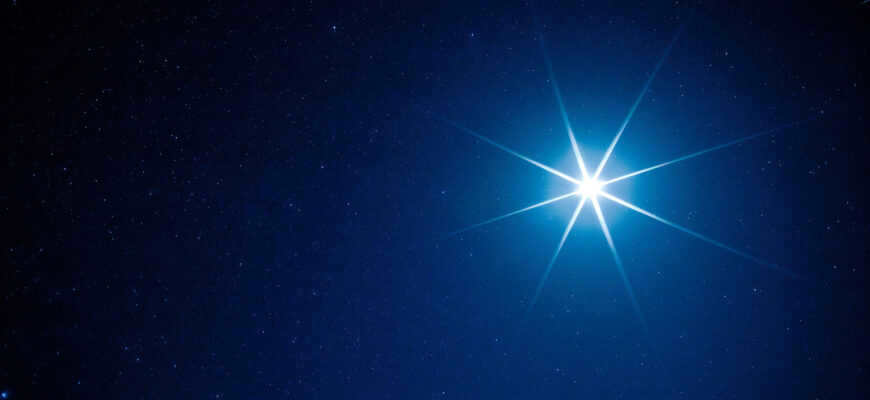
Curious information
When examining the query about which stars shine the brightest in the nocturnal sky, it is important to note that this compilation excludes planets. For instance, Venus closely resembles a brilliant star, while Jupiter takes on this role during the summertime, surpassing all other celestial bodies. On occasion, the red planet Mars is clearly visible, standing out amidst the other stars. The Sun is not included in this list, as there is no comparison, even during daylight hours.
The most brilliant star
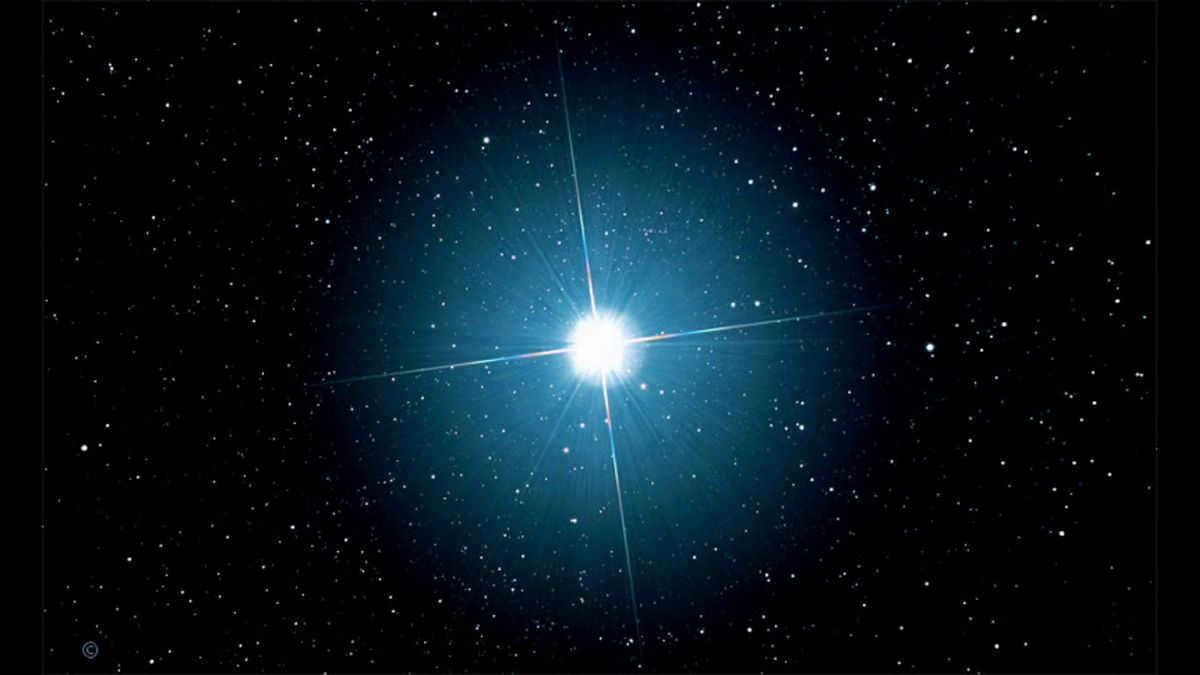
Sirius is not only the most luminous star in the constellation Canis Major, but also in the entire celestial sphere. One might assume that it is also the hottest and largest star, given its remarkable brightness. However, this assumption is incorrect. Sirius is relatively close to Earth compared to other stars, with a distance of 8.6 light years. Therefore, it is one of the nearest stars to our planet, which explains its prominent visibility.
Sirius is particularly prominent during the winter months. It shines brilliantly in the southern night sky, situated to the left of Orion. As spring approaches, the star gradually moves westward and begins to sink below the horizon. During the summer, it is not visible at all.
Characteristics of Sirius
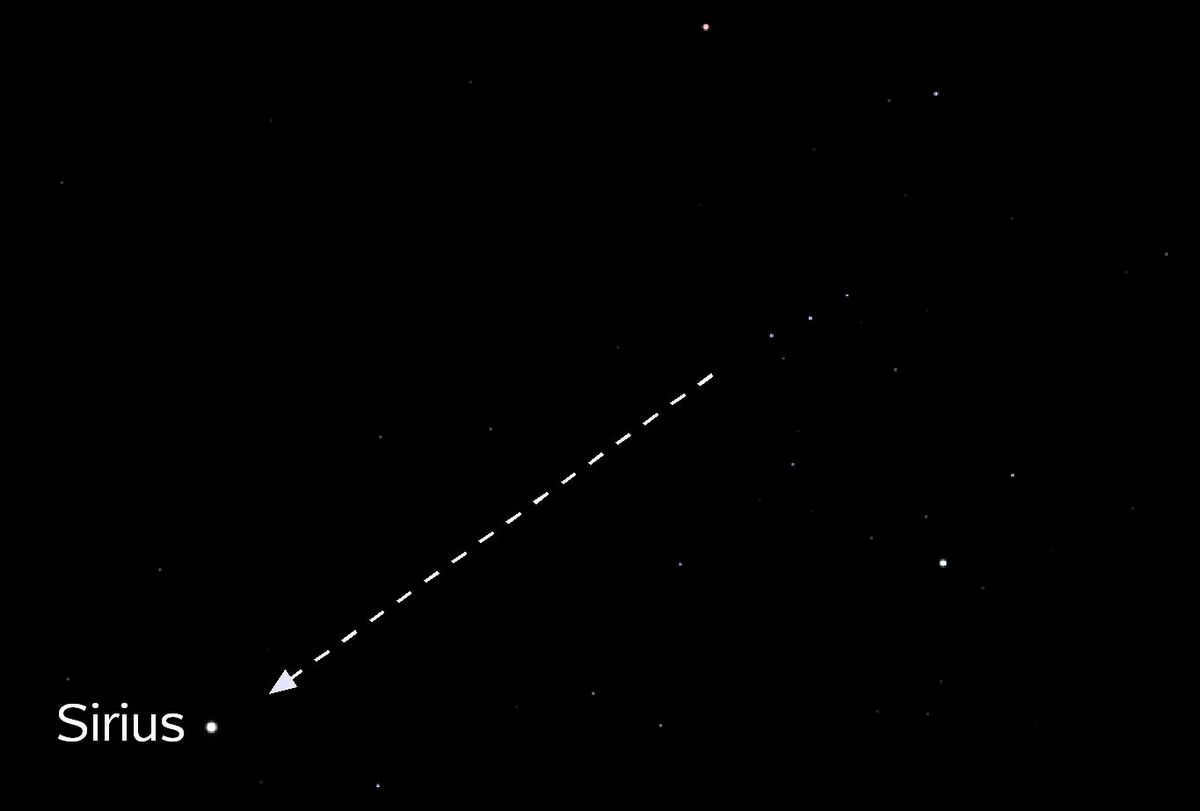
The brightest star is actually a binary star system. The primary star is incredibly hot and is twice as massive as the Sun, as well as significantly larger in size. There is nothing particularly extraordinary about Sirius.
In terms of its life cycle, it follows a rather mundane path: after approximately 660,000,000 years, the star will evolve into a red giant and eventually become a white dwarf.
Situated twenty light-years away from Sirius is a fascinating white dwarf known as Pup or Sirius B. This star completes a full orbit every 50 years. While it is not particularly large, comparable in size to Earth, it possesses an incredibly high mass similar to that of the Sun.
Pup exhibits an immense density. Just a matchbox-sized amount of its material would weigh around 1,000 kilograms.
Other prominent stars
The magnitude of the white dwarf is 8.6 m. If the Puppy is situated at the farthest point from Sirius A, it can be easily observed even through a compact telescope.
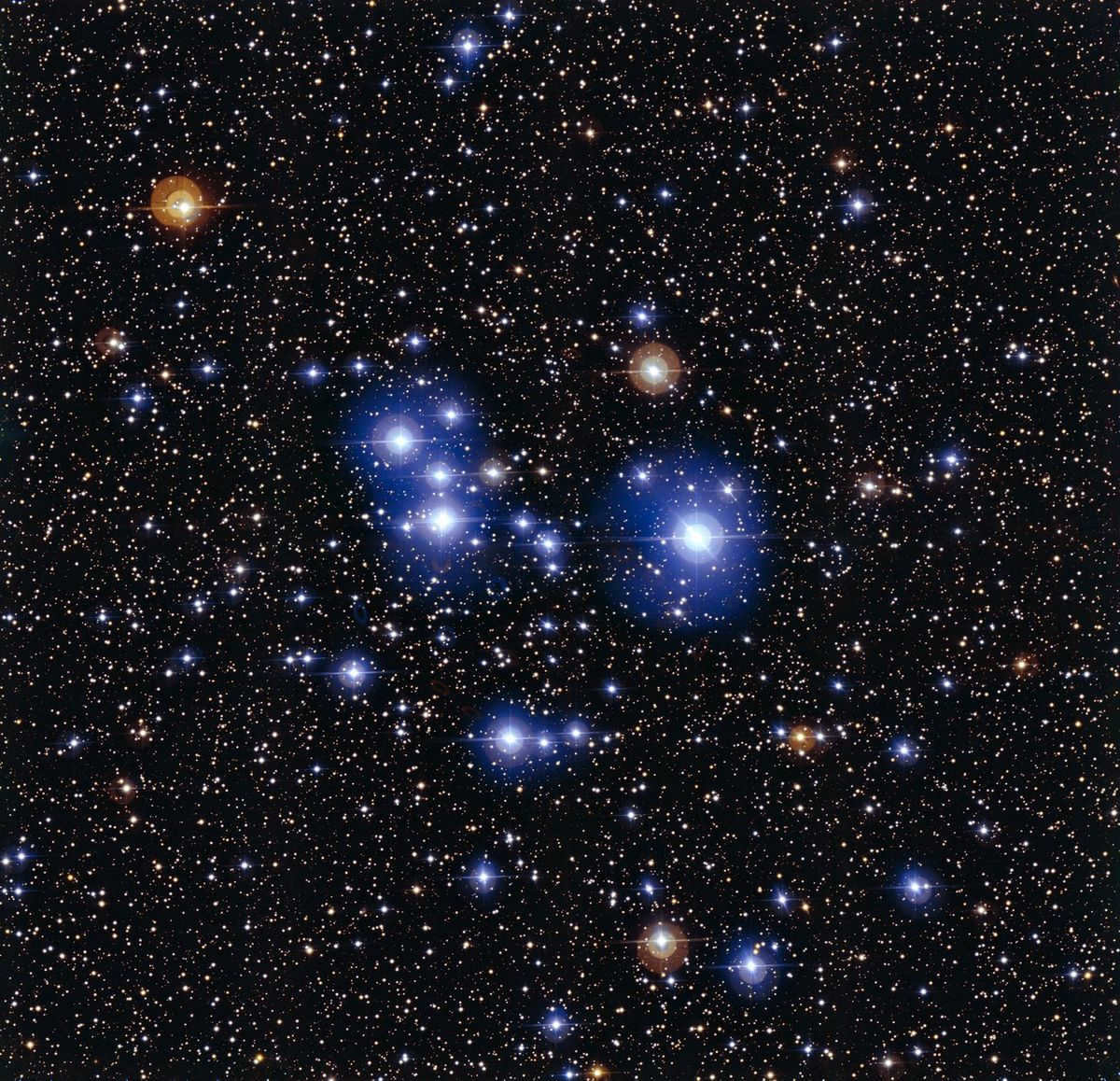

There are only a few dozen stars that shine the brightest among all. Each of them has its own unique characteristics. Some stars, like Toliman, are similar in size to the Sun, while others are slightly larger. There are also true giants, such as Betelgeuse.
- Canopus,
- Toliman,
- Arcturus,
- Altair,
- Deneb,
- Spica,
- Vega,
- Arcturus,
- Capella,
- Betelgeuse.
These celestial bodies are situated at different distances from our planet, so the brightness alone cannot be used as a determining factor. For instance, if the Sun were to switch places with Sirius, it would incinerate the Earth, instantly vaporizing all of its oceans. Similarly, if Betelgeuse were to engulf the Earth, it would be completely consumed.
Are you fascinated by the beauty of the starry night sky? Share your thoughts on TourJournal.
Contact us at +7 926 604 54 63
In this post, we will explore the ten most luminous stars in the night sky and other related celestial objects, organized based on their relative positions on the celestial sphere.
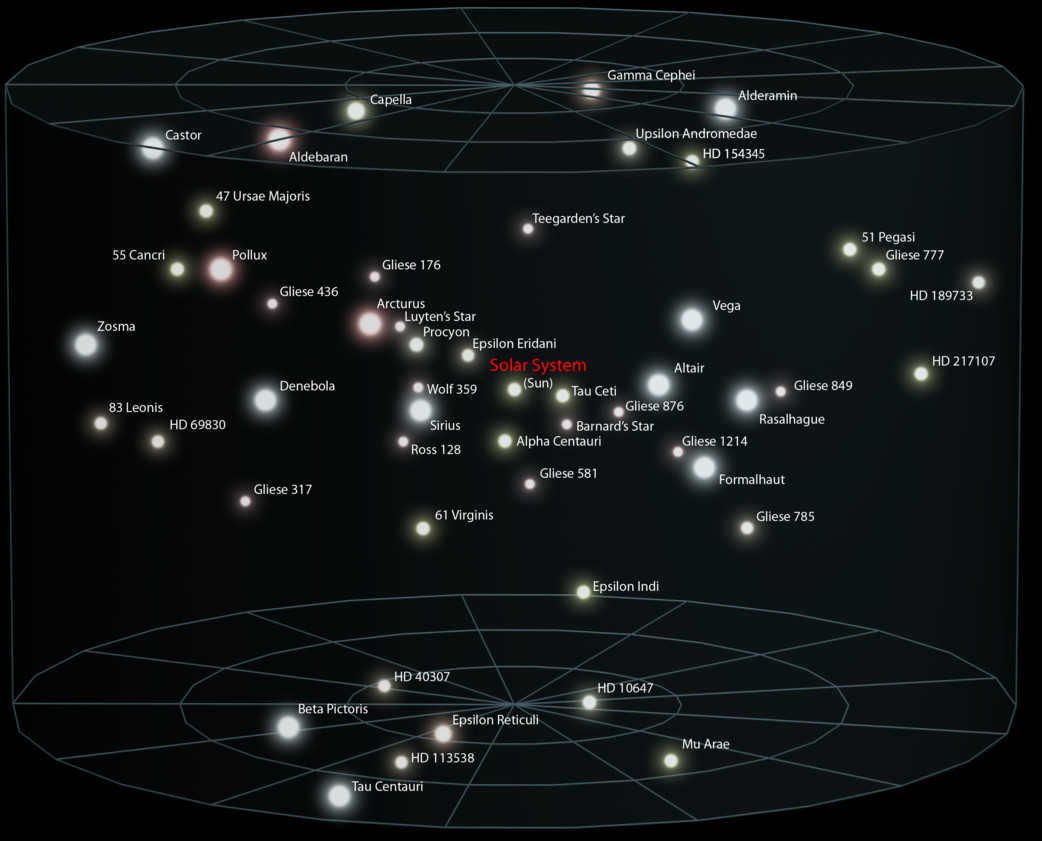
In a previous article titled “Exploring the Starry Sky Beyond Stars: A Guide to Astronomy with Binoculars,” we discussed a variety of deep space objects that can be observed using binoculars. These objects have apparent stellar magnitudes ranging from +9 m to +10 m, making them visible to the naked eye. In this article, we will focus on bright stars that can be easily identified on the celestial sphere without the need for optical instruments. These stars are part of recognizable asterisms, which are distinct groups of stars.
The nearest galactic neighborhood is where an observer on Earth can find the brightest stars, which are typically located within a few hundred light-years. These stars are not randomly distributed, but rather influenced by local galactic structures such as the Milky Way plane or the “Gould belt”. Additionally, areas with a high concentration of bright stars often coincide with clouds of interstellar gas, as can be observed in the Orion Nebula. Therefore, studying stars solely based on their brightness may not be the most logical approach. Instead, it is more useful to view this list as a mnemonic tool for selecting information, similar to how the previous article in this series focused on “strange space objects” based on their location within the constellations of the Zodiac.
Right Ascension: 05h 14m 32s, Declination: -08°12′06″, magnitude 0.13 m
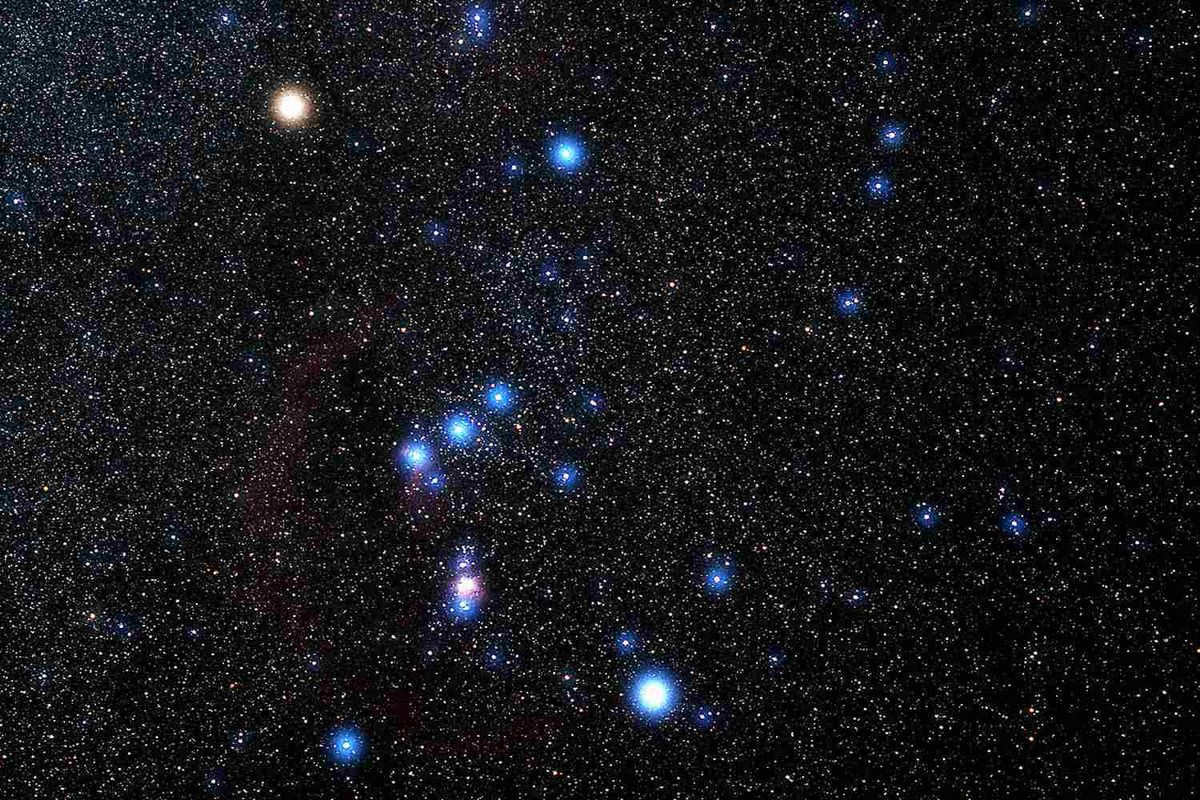
Rigel is the brightest star in the constellation of Orion and the seventh brightest star in the night sky, located approximately 860 light years away. It appears as a blue supergiant of spectral class B when observed in the sky, but with the help of a small telescope or binoculars, its paired component can be distinguished. It is believed that the Rigel system is quadruple, or at least triple. The main star, known as Rigel A, is a supergiant with a mass equivalent to 21 times that of the Sun. Rigel B consists of two possible stars, Ba and Bb, which are blue-white subdwarfs belonging to the main stellar sequence, with masses of approximately two times that of the Sun. In addition to Rigel, there are other notable stars and nebulae in this region of the sky, all located at a similar distance. Together, these celestial objects form the constellation of Orion, which is easily recognizable by its distinct shape and is positioned along the celestial equator.
There are numerous bright stars that are located close to the Sun and are situated in the plane of the Milky Way. Interestingly, most of these stars are found in the southern hemisphere or near the celestial equator, with only two out of ten stars having a noticeable northern declination. This pattern is also observed in nearby “deep space objects” such as nebulae and star clusters. This distribution across the sky is not a coincidence but is instead influenced by the unique local structure of the Galaxy arm. When observed up close, this structure appears like a disturbance in the form of a “wave” or “ripple” on the galactic disk. This disturbance causes some bright stars and interstellar gas-dust clouds to deviate from the plane of the Galaxy, resulting in their displacement in various directions relative to the arc of the Milky Way in the sky. This distinctive structure has been known since the 19th century and is now referred to as [Name]. Recent discoveries have revealed that it is part of a larger wave structure known as [Name], which has an approximate lifespan of 50-60 million years. This wave structure is believed to be caused by a significant perturbation in this particular region of the Galaxy. We have previously discussed this topic in more detail.
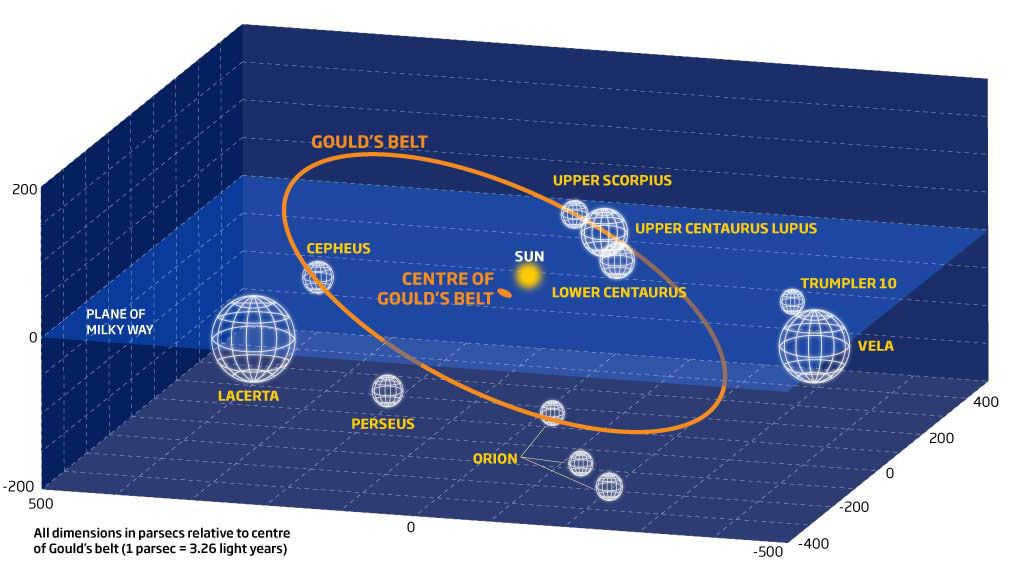
When you look up at the sky, you can see a fascinating phenomenon known as Gould’s belt. It is a collection of young and bright stars that are arranged in the shape of a belt. This belt is tilted at an angle of 20° to the plane of the Milky Way, giving it a unique appearance. Interestingly, the Sun is slightly off-center within this belt, and the plane of our solar system is also tilted in relation to the Galaxy’s disk. As a result, the southern hemisphere is privileged with a greater number of visible bright stars compared to the northern hemisphere.
If this particular wave did not exist, the Milky Way would lose many prominent stars and clouds. One notable example is the Orion constellation, which contains a variety of objects such as young, highly luminous stars (known as “OB-associations”), clusters, and gas and dust clouds (like the Orion Nebula). These numerous nebulae in Orion were discovered to be positioned below the galactic disk, causing them to shift towards the southern hemisphere, right at the celestial equator. Similarly, structures in the Scorpius constellation in the southern hemisphere, including the bright star Antares (the fifteenth brightest in the sky), exhibit similar characteristics. The Redcliffe wave effectively transported these structures to the opposite side of the galactic plane, resulting in the constellation appearing further north than the Milky Way’s arc, allowing it to be visible from the northern hemisphere. Additionally, these structures in Scorpius happen to be the closest to us.
2. Betelgeuse
Right Ascension: 05h 55m 10s Declination: +07°24′25″, magnitude +0.5
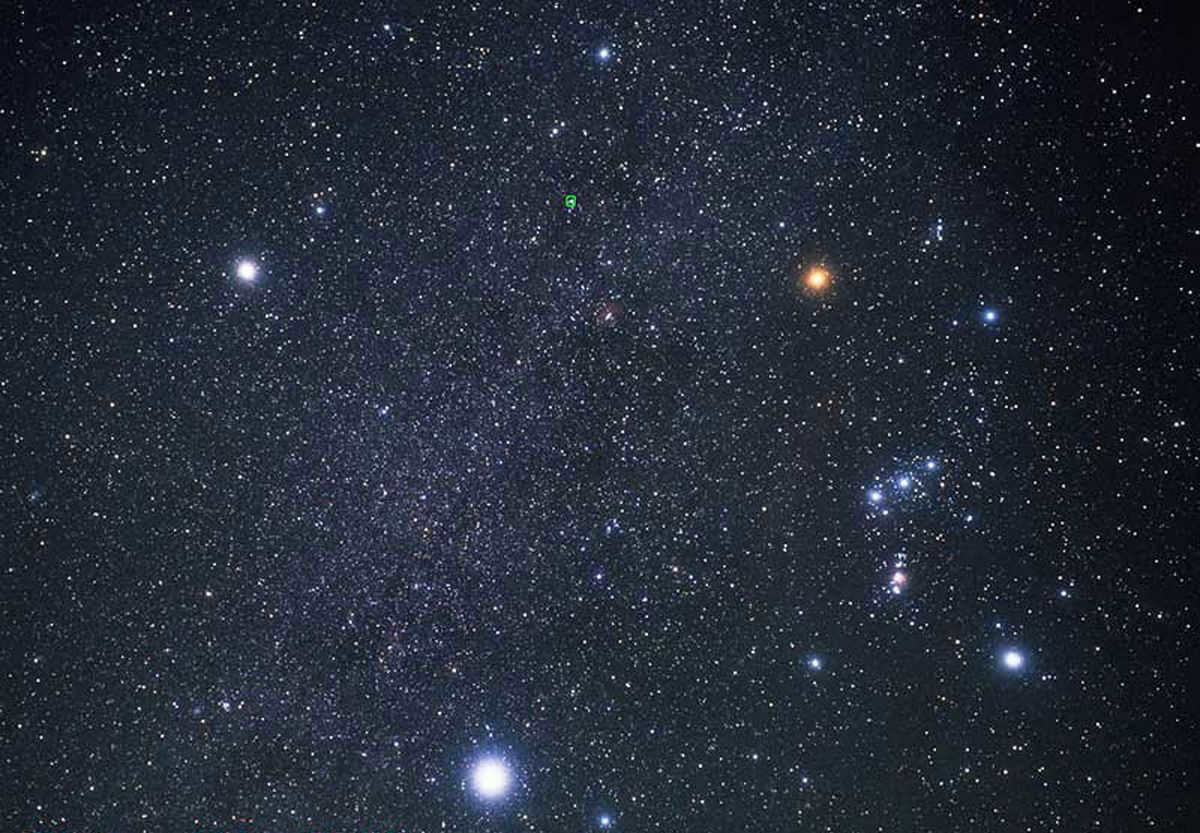
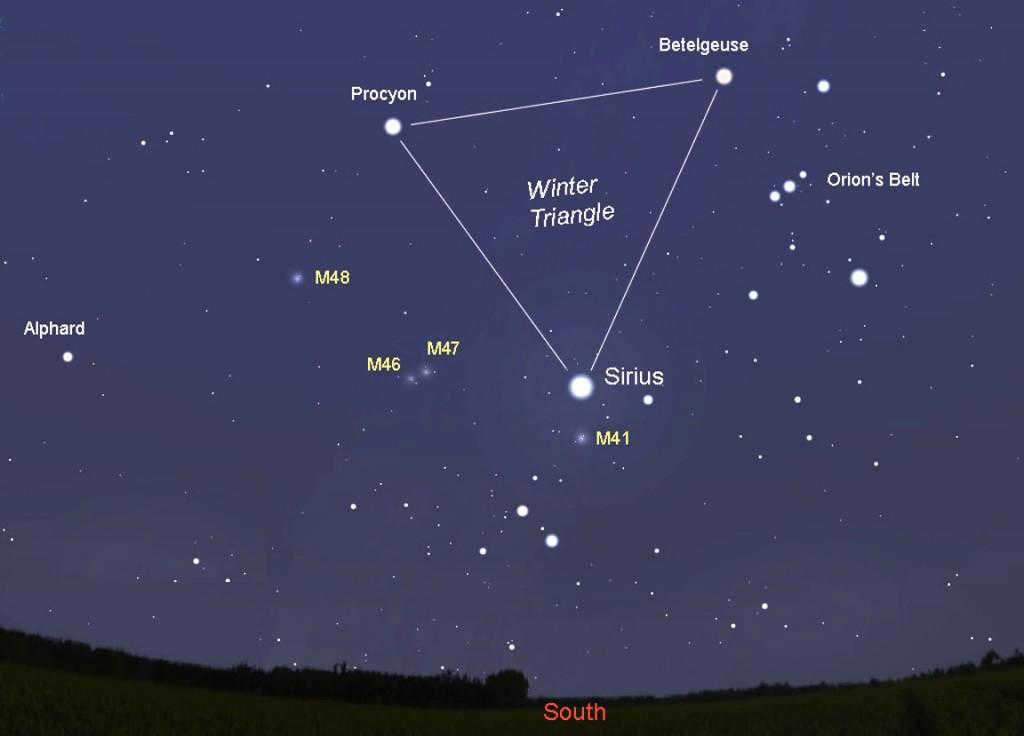
– is a star with variable brightness (its apparent magnitude varies from 0 m to +1.6 m) located in the constellation of Orion (Alpha Orion) approximately 700 light-years away. It is among the ten brightest stars and is easily distinguishable in the night sky due to its reddish hue, which contrasts with the hot blue-white stars of Orion.
It is the largest star that can be seen with the naked eye: if it were in the Solar System, its size would be somewhere around the orbit of Jupiter. As a result, it was the first star after the Sun to have its transverse dimensions measured and to be perceived as more than just a point in the early 20th century. Betelgeuse is a red supergiant in the final stage of its evolution, which will eventually culminate in a supernova explosion. This inevitable event is expected to take place within the next few thousand or tens of thousands of years. There have been several reports, including in Russian, stating that the star is expected to explode in the next week. These notes were likely the result of some astronomical news being rewritten and a lack of understanding of the subject matter by the authors. It is currently impossible to predict this event, especially down to the exact day. There are several other supergiant stars in the vicinity of the solar system that could potentially explode as supernovae of this type (such as Spica, Antares, Rigel, etc.), and there have been several such explosions documented in historical times.
3. Sirius
Sirius is located at RA: 06h 45m 09s and Dec: -16°42′58″. It has a magnitude of -1.46 m.
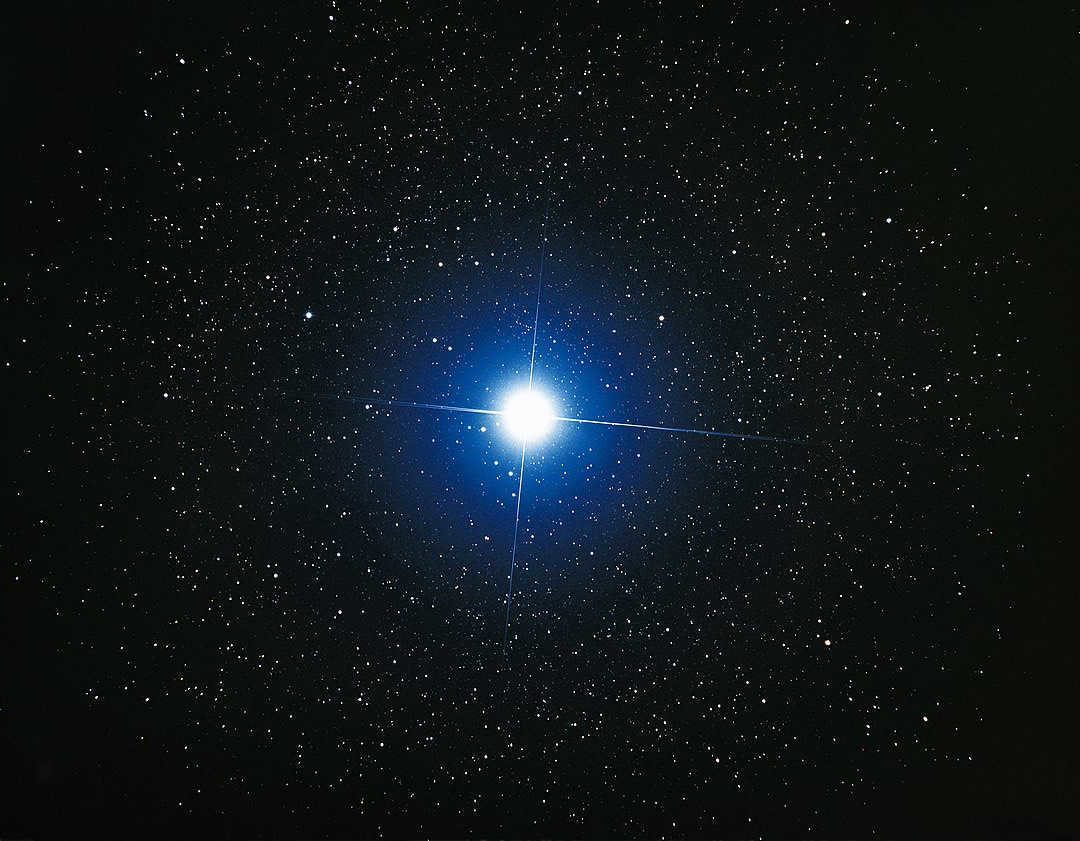
4. Procyon
Right Ascension: 07h 39m 18s, Declination: +05°13′30″, magnitude: +0.34 m
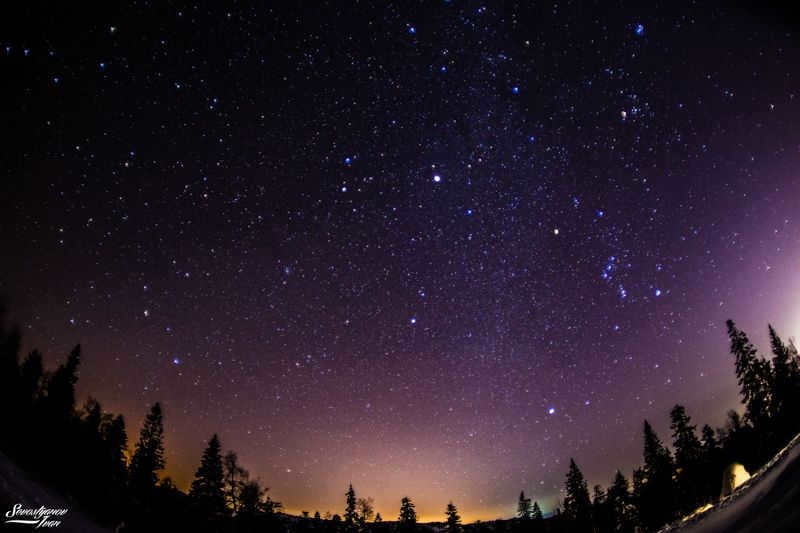
– Sirius, the most luminous star in the constellation Canis Minor and the eighth brightest in the nighttime sky, is located at a distance of 11 light-years. This star system is also a binary system, consisting of a primary component that is a white-yellow subgiant of the F5 class nearing the end of its evolution (just before it expands and becomes a red giant) and a companion component that is a white dwarf, which is only visible with a powerful telescope.
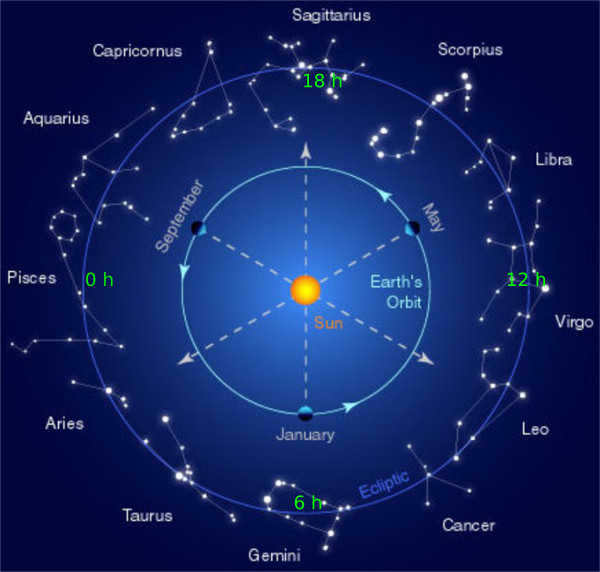
5. Ahernar
Right Ascension: 01h 37m 43s, Declination: -57°14′12″, magnitude +0.4 m
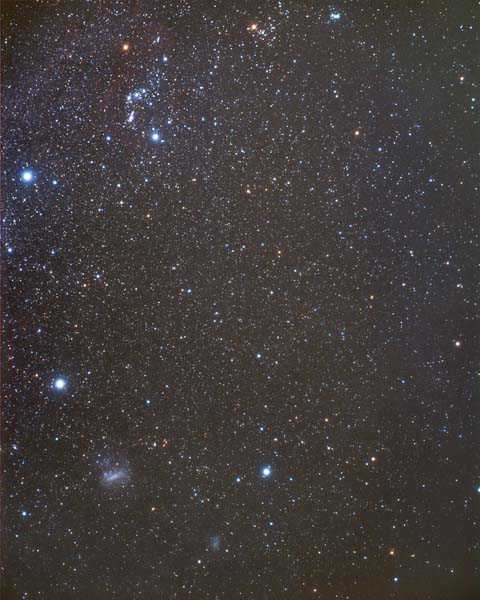
– Sirius is the most luminous star in the Eridanus constellation, located 140 light-years away. It is classified as a blue-white B-class giant and is the hottest among the top ten brightest stars, with a surface temperature ranging from 10,000 to 20,000 K. In terms of visual appearance, it is the bluest star among them. Recently, it has been discovered that Sirius is a binary star system, consisting of a larger primary star and a smaller companion star. The companion star is twice as massive as the Sun, and the two stars orbit each other with a period of approximately 14 years.
Ahernar stands out because of its rapid rotation speed around its axis: it spins at a speed of approximately 300 km/sec at the equator. This rapid rotation causes the star to become highly flattened, with its equatorial diameter being one and a half times larger than its polar diameter, thanks to centrifugal force. To put this into perspective, the Earth is compressed by about 20 km at the poles due to its rotation, while the Sun only experiences a flattening of 0.001%. This intense rotation also leads to the star’s substance being ejected into the surrounding space, forming a shell of gas and plasma. This phenomenon contributes to the star’s heightened luminosity in the infrared spectrum.
6. Canopus
Right Ascension: 06h 23m 57s, Declination: -52°41′44″, Magnitude: -0.74 m
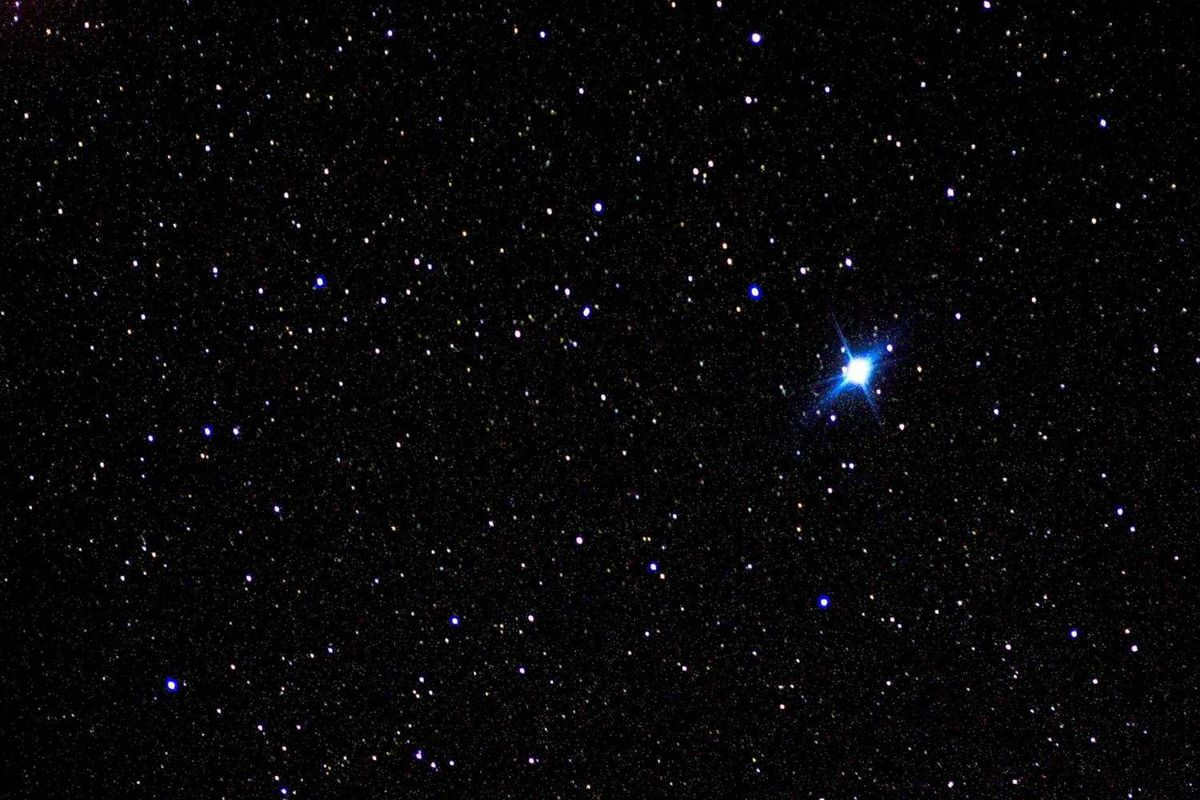
– Canopus is the second brightest star in the night sky, ranking just behind Sirius. It can be found in the southern constellation of Carina, also known as the Keel. Canopus is classified as a yellow supergiant star, and it is currently in a late stage of evolution with a spectral class of A9 or F0. The star has a mass of approximately 8-9 times that of our Sun and is located about 310 light-years away from Earth. Canopus is situated in the southern sky, making it visible only from certain latitudes in Europe, such as those south of Athens, as well as from the southern Iberian and Anatolian Peninsula. In the past, Canopus was even further south due to the precession of the Earth’s axis. It is believed that during this time, the star may not have been visible from mainland Greece and Rome, but it could still be observed from Egypt.
Canopus was utilized for maritime navigation in the southern latitudes. Due to the absence of a star similar to Polaris in the northern hemisphere, which is located at the southern celestial pole, various techniques were employed to determine direction by observing the bright stars in the southern sky. These methods helped ascertain the orientation towards different cardinal directions. One specific approach involves utilizing the stars Canopus and Ahernar, along with the southern pole of the world, to form an equilateral triangle. Since the 1960s, Canopus has even been employed in astronautics as a reference point for determining the spacecraft’s orientation using star sensors.
7. Alpha Centauri
Right ascension: 14 hours 39 minutes 35 seconds, Declination: -60 degrees 50 minutes 15 seconds, magnitude -0.27 m
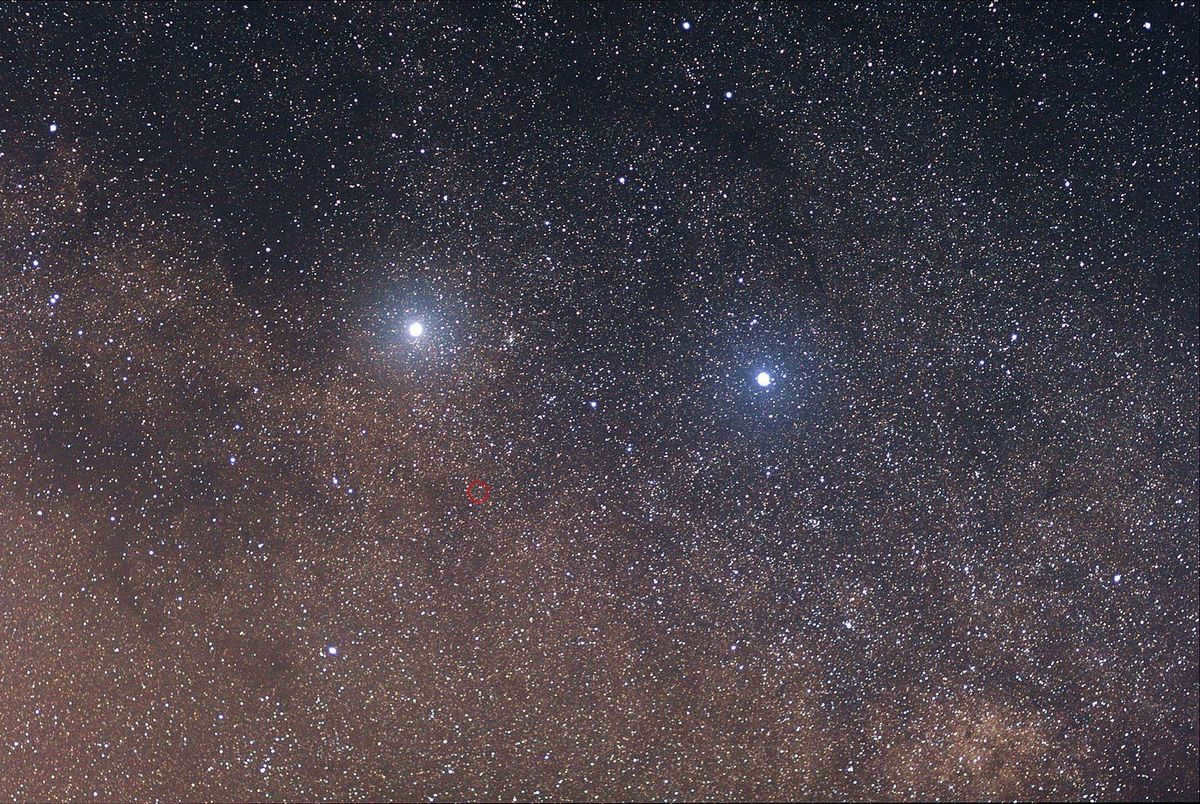
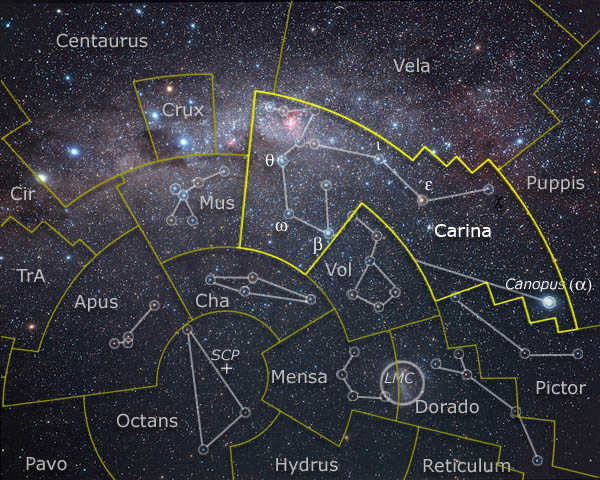
– Alpha Centauri is the third most luminous star in the nocturnal firmament within the southern asterism known as Centaurus. Additionally, it holds the distinction of being the nearest stellar system to our Sun, positioned a mere 4.3 light-years away. It is important to note that Alpha Centauri should not be confused with Rigel, another celestial body sharing the same name. While Rigel is also among the ten brightest stars, it resides in the constellation Orion and remains visible from every location in the northern hemisphere, unlike Alpha Centauri.
The star system consists of three stars. The first two stars, known as α Centauri A and B, are very similar to our Sun and are so close together that they cannot be distinguished as separate objects. The third star is a red dwarf, located at a considerable distance from the other two stars on the celestial sphere and cannot be seen without the aid of a telescope (it is indicated by a red circle in the photo). Recently, a planet similar to Earth was discovered in the “habitable zone” near the star Proxima Centauri – you can find more information in the article.
Alpha Centauri is located near the celestial sphere and is known as one of the most luminous stars in the night sky. It has an apparent stellar magnitude of +0.6 m, making it highly visible to the naked eye. Although it is not officially ranked in the top ten brightest stars, it still holds a prominent position in the sky. Alpha Centauri is part of a triple star system and is located at a distance of 390 light years, making it significantly farther away than Betelgeuse.
8. Arcturus
Right Ascension (RA): 14h 15m 40s, Declination (Dec): +19°10’56”, magnitude: -0.05 m
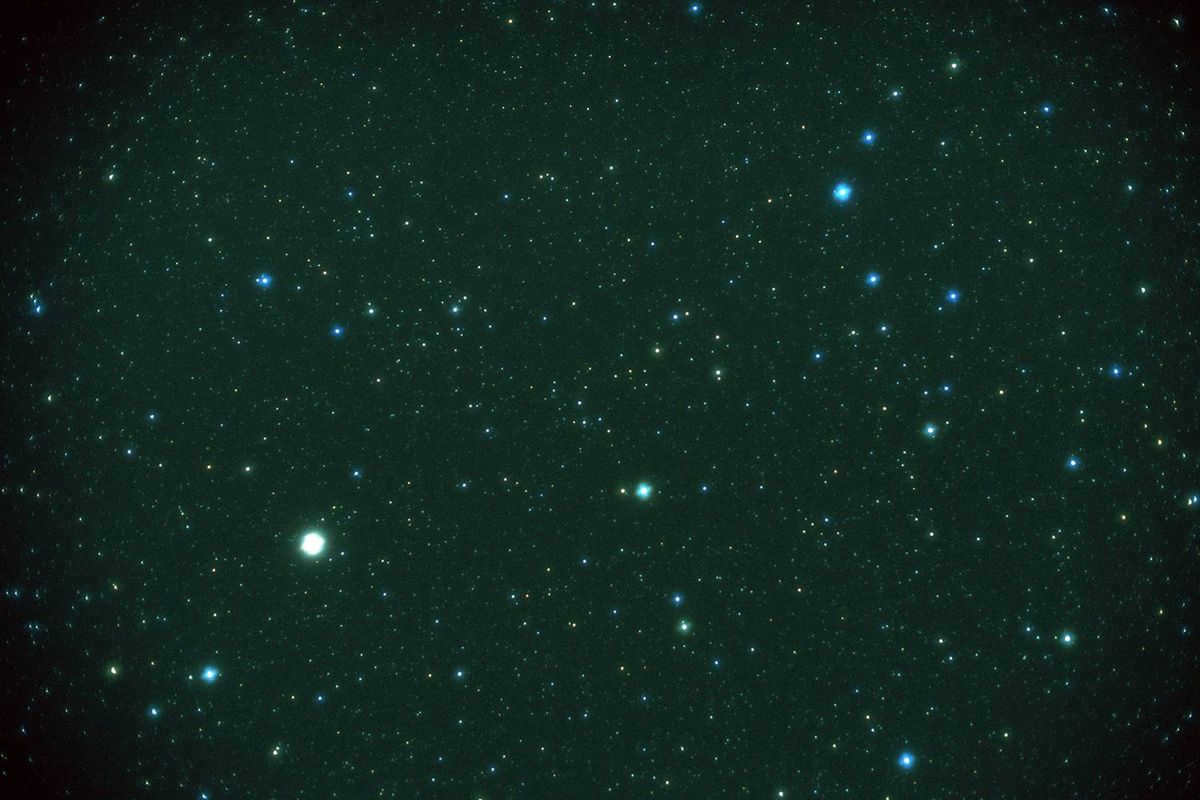
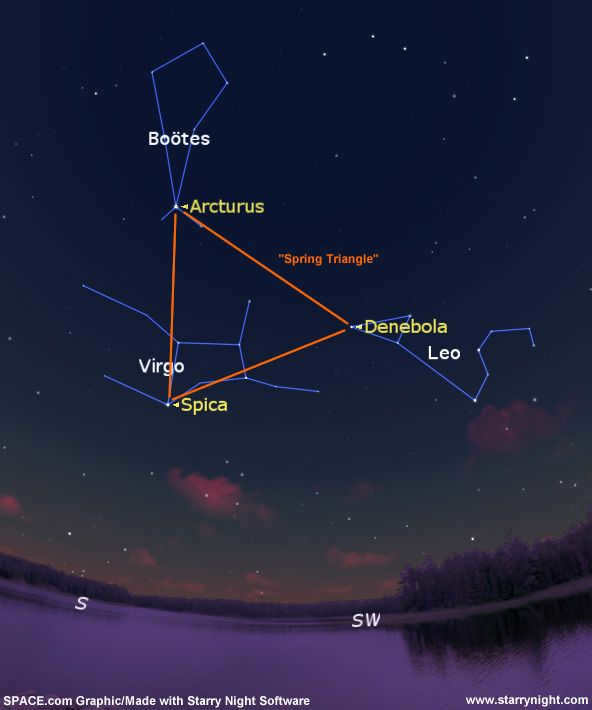
– Arcturus is a red giant located in the constellation Volopassus (Boötes) in the northern hemisphere. It is situated 34 light-years away and is the fourth brightest star in the sky. Arcturus has a mass that is one and a half times greater than the Sun, but its temperature is lower due to its red giant phase. As a result, a significant portion of its energy is emitted in the infrared part of the spectrum. In terms of absolute brightness, Arcturus is 100 times brighter than the Sun in the visible range and 200 times brighter across the entire spectrum, including the infrared. The Sun is expected to enter its red giant phase in a few billion years after depleting its hydrogen reserves through thermonuclear reactions.
Arcturus is the highest point of a different asterism known as the “triangle,” which also includes the stars (α Virgo) and (β Leo). Spica is one of the twenty brightest stars, while Denebola is ranked around 60th in terms of brightness. In an alternate version, the star (α Leo) is given as the highest point instead of Denebola: it is brighter, but the equilateral “triangle” is more elongated and harder to locate. These stars are typically identified by the distinct lines of the Big Dipper’s handle, as shown in the diagram.
9. Capella
Right Ascension: 05h 16m 41s, Declination: +45°59’53”, magnitude +0.08 m
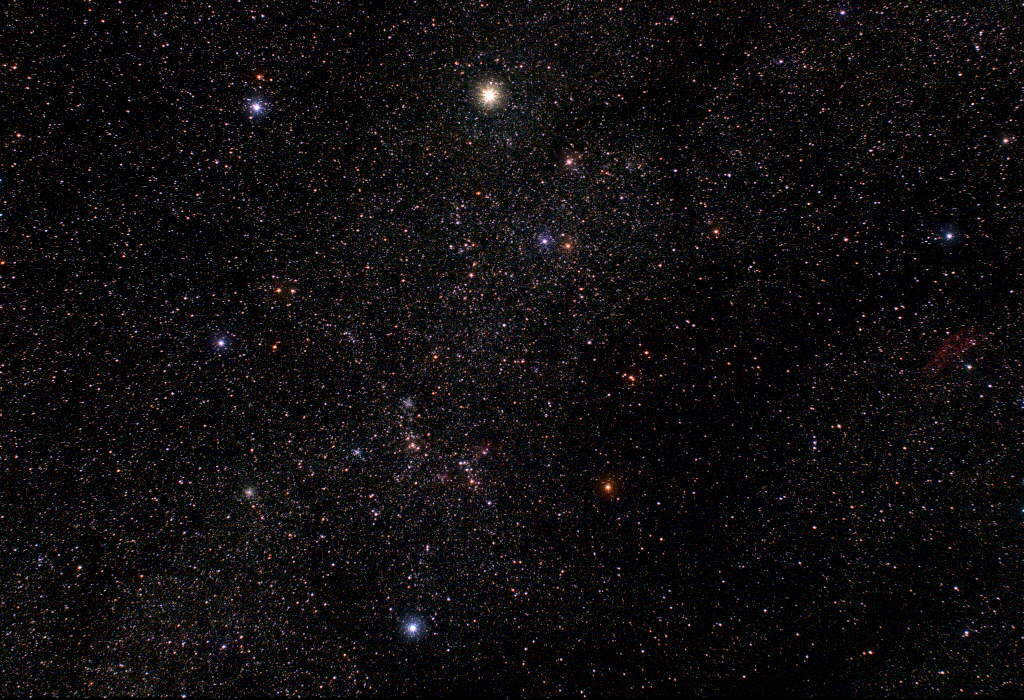
– Capella, a bright yellow star located in the constellation Auriga, is a giant star that is larger than our Sun. It is situated 41 light-years away from us and is classified as a G5 star. Although the Sun is also classified as a G-type star, it is considered a “yellow dwarf” of subclass G2V. Capella is the sixth brightest star in the sky.
10. Vega
Right Ascension: 18h 36m 56s, Declination: +38°47′01″, magnitude +0.03 m
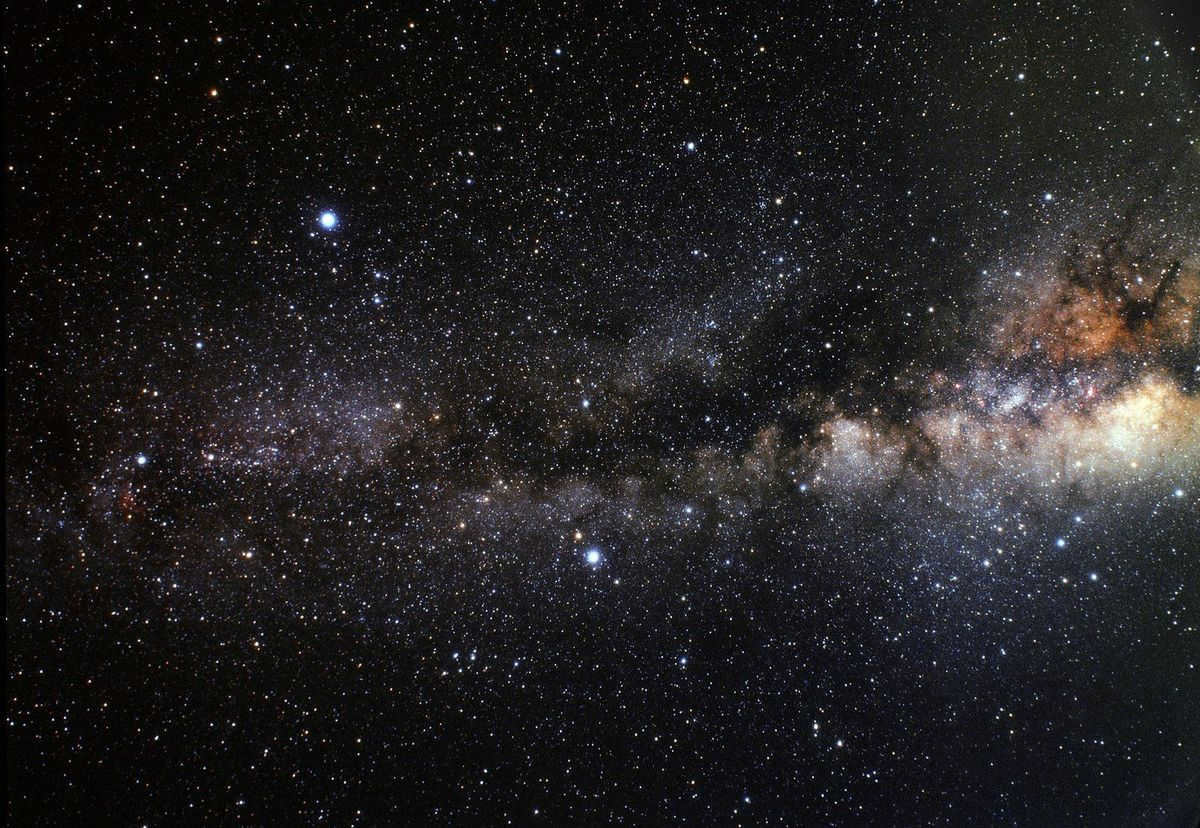
– Vega is a star of the A0V class, which means it is a bluish-white Main Sequence star. It is twice as massive and 40 times brighter than the Sun. Vega is located at a distance of 25 light-years in the constellation Lyra, in the northern hemisphere. It is the second brightest star in the Northern Hemisphere, only surpassed by Arcturus. In fact, it is the fifth brightest star in the entire night sky.
Interestingly, due to the precession of the Earth’s axis, Vega used to be the “Polaris” about 15,000 years ago. This means that the Earth’s axis of rotation was directed towards Vega, rather than towards α of the Little Bear as it is in our era. However, in 12,000 years, the pole of the world will once again move towards Vega.
Vega has been extensively studied throughout history, making it a star of great historical interest. It holds the distinction of being the first star, aside from the Sun, to be photographed back in 1850. Additionally, Vega was one of the pioneering stars to have its distance determined using the parallax method, which involves measuring its displacement on the celestial sphere caused by the Earth’s annual motion. In the 1870s, scientists were also able to obtain an emission spectrum for Vega, further adding to its significance.
Furthermore, Vega was once used as a standard for determining apparent stellar magnitudes. Stellar magnitude is measured on a logarithmic scale, where a decrease in brightness by a factor of 100 corresponds to an increase in stellar magnitude by 5 units. For example, a star with a magnitude of -1m is 100 times brighter than a star with a magnitude of 4m. In this context, Vega’s brightness was considered the zero-point, with an assumed apparent magnitude of 0m.
The Summer-Autumn Triangle consists of Vega (α Swan) and α Eagle). It is situated directly on the arc of the Milky Way, but the view of the Milky Way is more breathtaking in this region. The reason for this is that the direction in the plane of the Milky Way points towards the center of the Galaxy in the southern constellation of Sagittarius, which contains a dense galactic nucleus and numerous stars. On the other side of the sky, where Orion is located, the direction is away from the center and towards less populated areas. As a result, the Milky Way is best observed and studied from the southern hemisphere, such as the Southern European Observatory in Chile or the observatory at Scott-Amundsen Station at the South Pole.
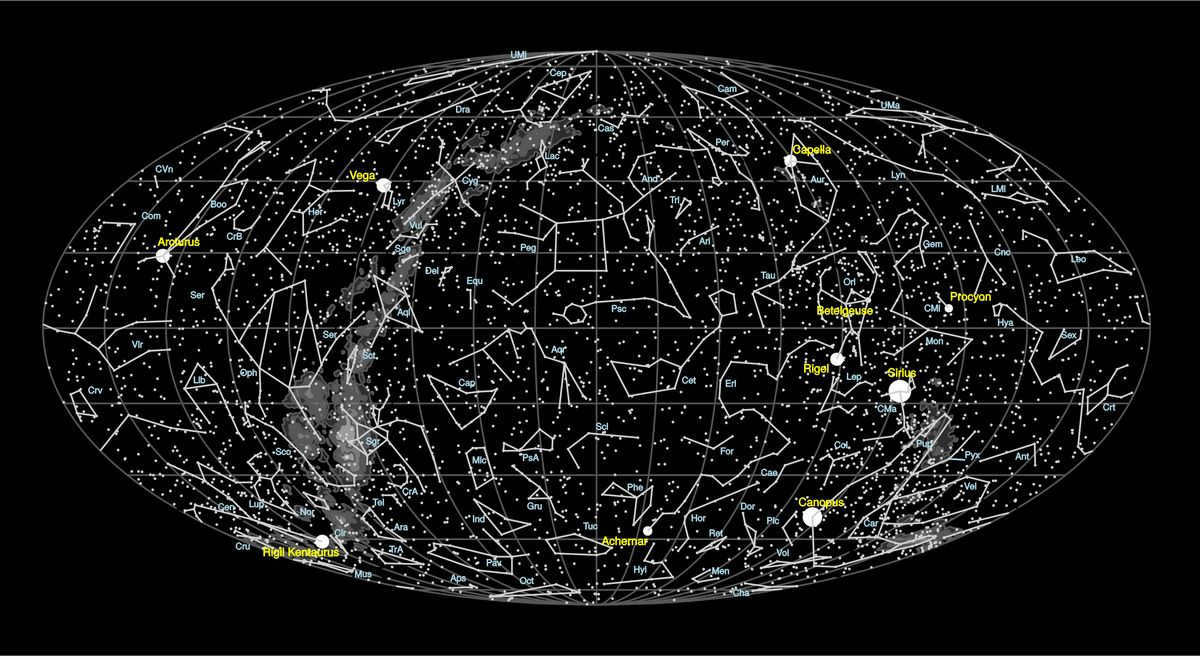
Additional article lists in the astronomy series
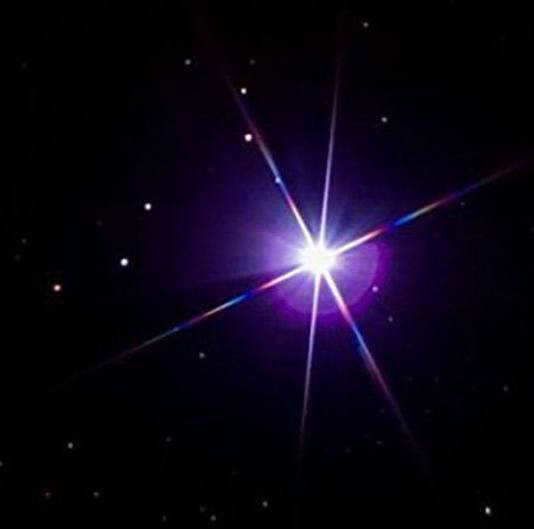
The brightness of Sirius cannot be measured in the usual cd/m² (lux) – astronomers only measure the star’s luminosity. Luminosity is measured in stellar magnitudes, and Sirius has a luminosity of -1.44m (stellar magnitude). The luminosity of stars is dependent on their distance from Earth.

1.7K posts 3.2K followers
Community guidelines
Please conduct yourself in a respectful manner, honor differing opinions, and avoid arguments – let us live in harmony. )
The statement “Sirius is 22 times brighter than the Sun” and “you can only measure brightness and luminosity” is quite amusing.
On our planet, we are unable to compare the brilliance of the Sun to any other star.
When gazing at the night sky, it is impossible to determine the location of Sirius. However, looking directly at the Sun will result in blindness.

Perhaps not in outer space, but rather in the vast expanse of the night sky?
The unit of illumination known as lux is unrelated to the concept of brightness.

Discovering the whereabouts of the Orion constellation in which galaxy is located.
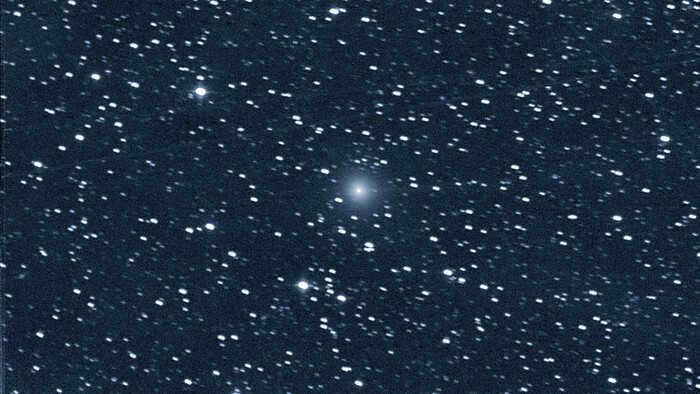
Comets are unexpected visitors. While the old ones, which we have long been familiar with, can sometimes disappoint us (which is not really surprising, as they have had time to deplete and melt during their repeated approaches to the Sun), newly discovered comets are often bright and stunning. However, this is not always the case.
Comet C/2023 P1 was first spotted by Japanese astronomer Hideo Nishimura on the night of August 11-12, 2023 – and it is still visible in the Gemini constellation. It can be said that the discovery of the comet was a stroke of luck, as finding a faint, hazy object (with a magnitude of 12) in the brightening predawn sky is a remarkable accomplishment that demonstrates the astronomer’s exceptional professionalism.
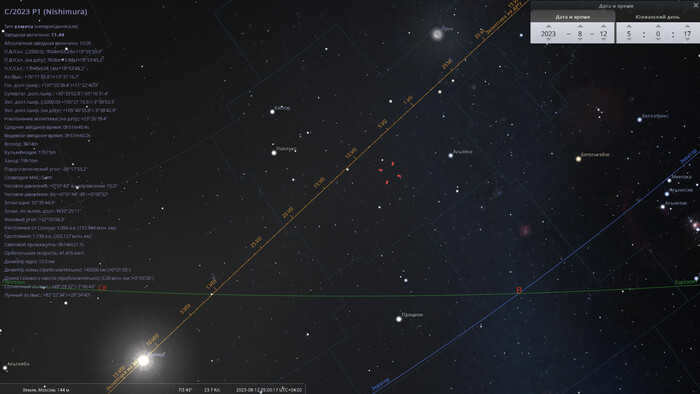
On the morning of August 12, 2023, comet C/2023 P1 was located in the constellation Gemini (at the time it was discovered).
However, the comet’s brightness has been increasing with each passing night. And now, after a week, it has already surpassed 10 stars in brightness. It is now visible through medium-power amateur telescopes. While it is still best seen before dawn, the overall viewing conditions for Nishimura’s comet have improved since its discovery.
What Comes After?
On September 18, 2023, the comet will reach perihelion (the point in its orbit closest to the Sun) at a distance of 33 million kilometers from its incandescent surface. That’s approximately twice as close as Mercury, although Mercury is a solid rock while the comet is composed of ice. As it approaches perihelion, the ice will begin to melt and vaporize. In fact, this process has already begun, and astronomers have observed a small tail (only 8-10 angular minutes in length) composed of gases and dust emitted from the comet’s heated nucleus.
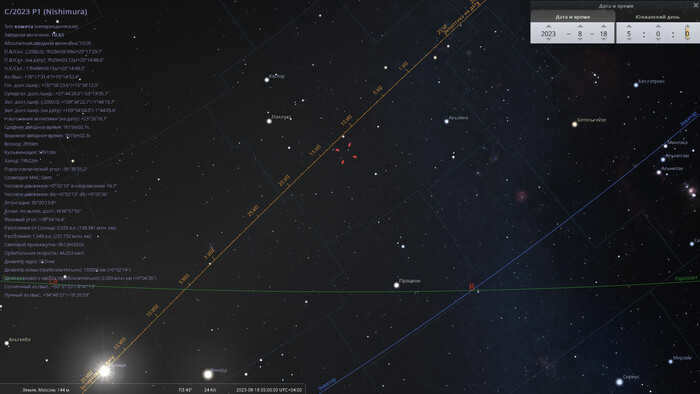
The position of comet C/2023 P1 in the constellation Gemini on the morning of August 18, 2023
Currently, the comet is traversing the Earth’s orbit and is located on the opposite side of the Sun. As a result, there is a considerable distance of one and a half astronomical units between the Earth and the comet. However, this situation is rapidly changing.
By early September, the distance between the Earth and the comet will decrease to one astronomical unit (and the distance between the comet and the Sun will be half an astronomical unit). Although the angular distance from the Sun (elongation) will slightly decrease from 35 to 30 degrees, this inconvenience will be offset by the increasing difference in declination between the Sun and the comet. In fact, the tail of the comet will be visible directly above the Sun, allowing for a clear view of the comet before sunrise.
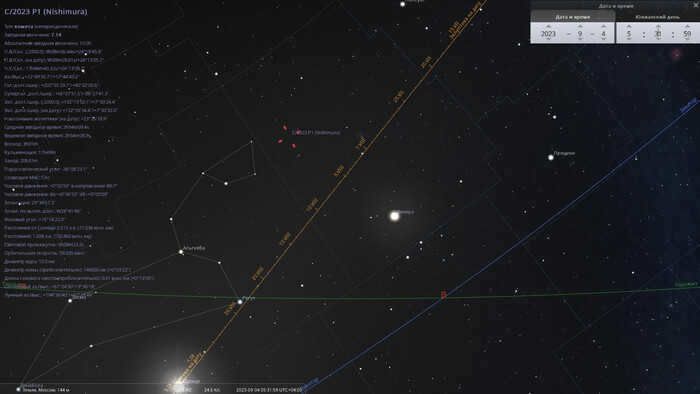
The position of comet C/2023 P1 in the constellation of Cancer on September 4, 2023
In the night sky, the comet C/2023 P1 Nishimura can be found in the constellation of Cancer, close to the border with the Leo constellation (look for the “Lion’s Head” asterism as a helpful guide). Additionally, the bright planet Venus will also be visible nearby in the same constellation. On September 4, 2023, the comet will reach a brightness of 7th magnitude, making it easily observable with binoculars.
On September 9, 2023, at dawn, comet C/2023 P1 will be located just 1 degree to the west of the star Adhafera (Zeta Leo), shining with a magnitude of 6. If you find yourself in an area with optimal conditions, such as mountains, deserts, or steppes, you will be able to observe the comet without the need for any optical aids.
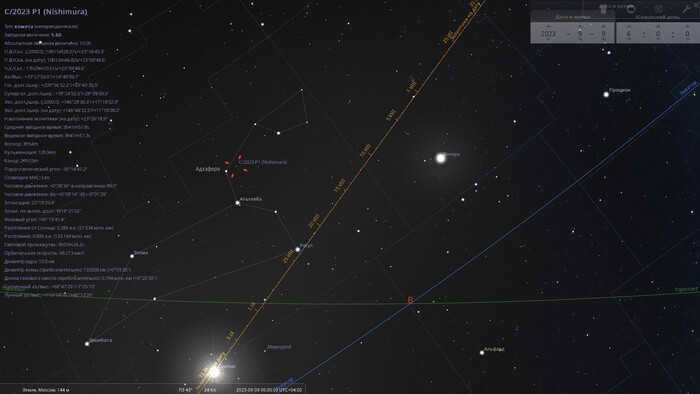
On September 9, 2023, in the constellation Leo, comet C/2023 P1 will be located at a specific position.
Regrettably, the distance from the Sun will decrease to 22 degrees, but the comet will ascend even higher above the ecliptic. Even with this slight elongation, its visibility will last for at least one and a half hours, and possibly up to two hours.
In the upcoming days, the comet’s brightness will continue to increase, but the distance from the Sun will decrease, making observation conditions more challenging.
On September 12 in the morning, the comet’s brightness will reach a magnitude of 5 stars, and its elongation will be reduced to 17 degrees. Meanwhile, the comet will still be positioned above the Sun, providing an opportunity to spot it in the morning twilight near the star Zosma (Delta Leo).
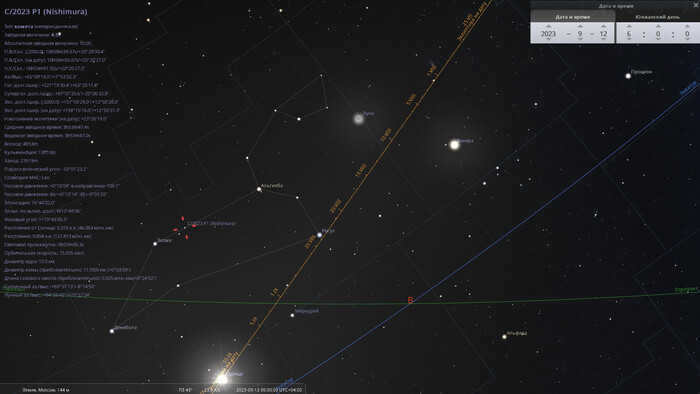
The position of comet C/2023 P1 in the constellation Leo on the morning of September 12, 2023
On September 15, in the morning, the comet will come close to the 2nd magnitude star Denebola (Beta Leo). Meanwhile, the comet will have a slightly lower brightness, approximately at the 3rd stellar magnitude. Despite the challenging conditions, it will be feasible to observe both celestial objects against the relatively bright dawn sky.
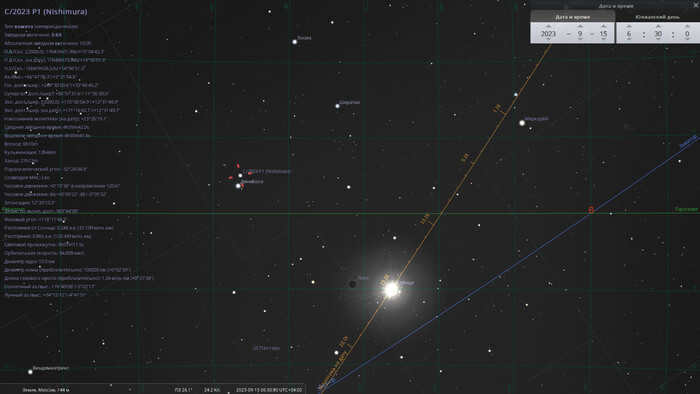
The comet C/2023 P1 will be located in the constellation of Leo on the morning of September 15, 2023.
During perihelion, the comet is expected to have a brightness of approximately 2nd magnitude. In the evening, observers in the northern hemisphere will be able to see the comet shortly after dusk, as it will be in the northern part of the constellation Virgo. However, in the southern hemisphere, it will be challenging or even impossible to observe the comet due to its higher declination compared to the Sun.
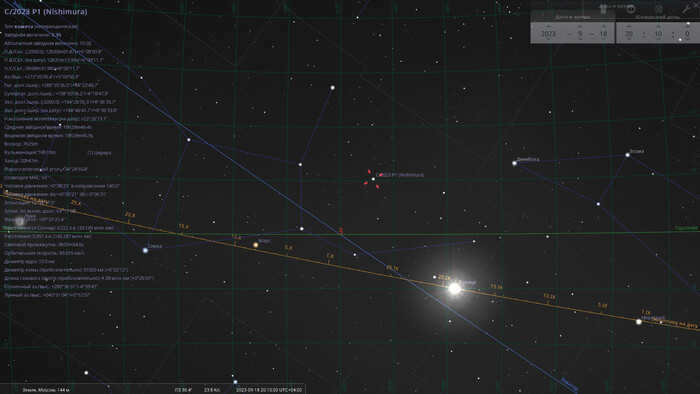
On the evening of September 18, 2023, the comet C/2023 P1 will be located in the constellation Virgo as it reaches perihelion.
As the days go by, the comet will continue to move further into the southern celestial hemisphere and will cross the equator at almost the same time as the Sun, just one day before the autumnal equinox on September 21, 2023. The comet’s brightness will also decrease to 4.5m.
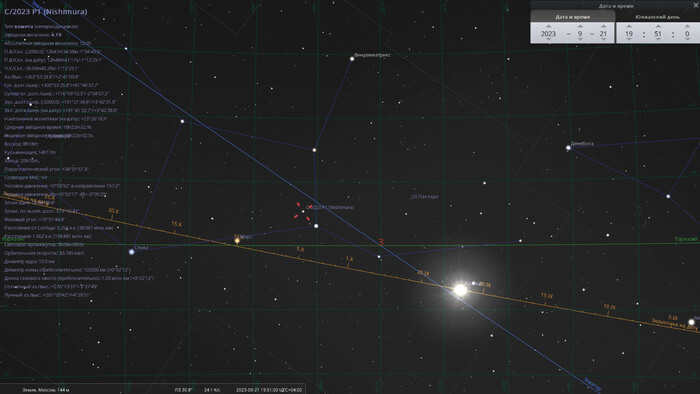
The position of comet C/2023 P1 in the night sky on September 21, 2023 can be observed in the constellation Virgo
If you want to see comet C/2023 P1 Nishimura on the evening of October 1, you should head to Australia or the mid-latitudes of South America, or maybe even the southern tip of Africa. The comet will be located on the border of the constellations Virgo and Raven, approximately 40 minutes after sunset. However, keep in mind that the comet will only have a brightness of about 7.5m, so it may not be worth buying tickets just for this event.
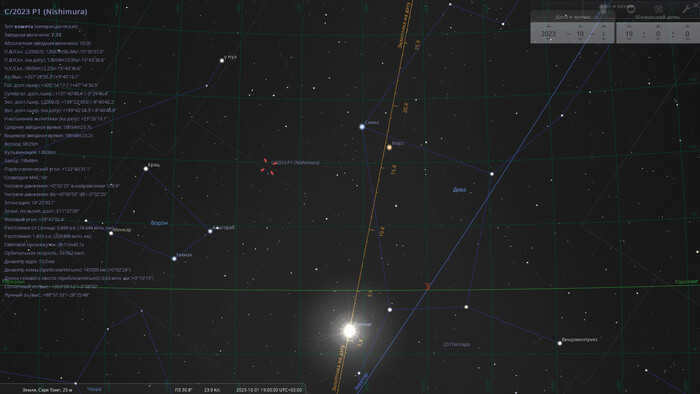
The position of comet C/2023 P1 on the evening of October 1, 2023 at the border between the constellations Virgo and Corvus (for an observer situated in Cape Town, South Africa).
By the middle of October, the comet will continue its journey southwards – in the trailing portion of the Hydra constellation, its brightness will diminish to the 10th magnitude, and visibility conditions even in the southern hemisphere of the globe will become unfavorable. In essence, at this stage, its observability for astronomy enthusiasts worldwide will come to an end.
When will the comet make its next appearance?
Not during our observation. Currently, the orbital elements have only been estimated with some degree of accuracy. This level of precision allows us to predict the comet’s position in the sky for the upcoming months, but the exact period of its orbit remains unknown. Despite being categorized as a long-period comet, its orbit’s eccentricity is said to be equal to one, indicating a close-to-parabolic or potentially parabolic trajectory. As a result, the comet may come back to the Sun in a million years or possibly not at all.
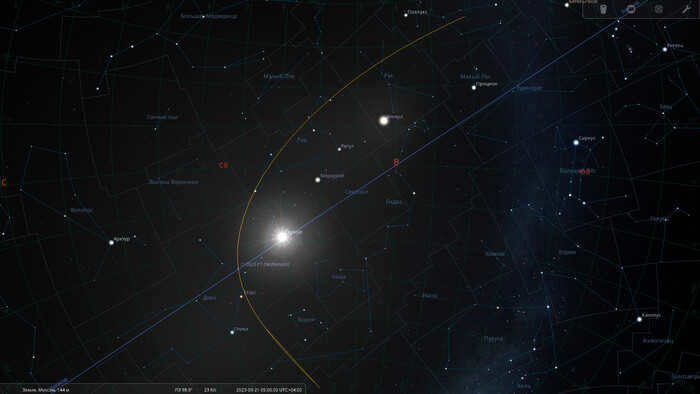
The trajectory of comet C/2023 P1 Nishimura from August 12 to November 1, 2023.
All maps are created using the Stellarium program.

The Galaxy Where the Orion Constellation is Located
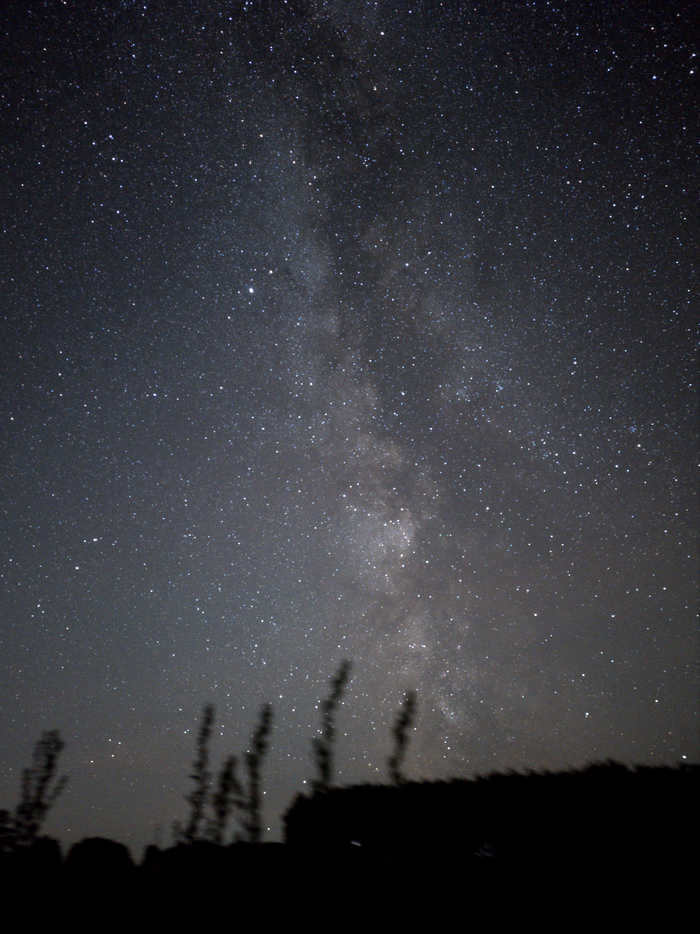
The constellation of Orion is located in the Milky Way galaxy. I captured this stunning astrophoto of the Milky Way using a Samsung s20fe camera in the Southern Urals, specifically in a green zone. The shutter speed was set to 15 seconds, and the ISO was set to 3200. I took a total of 10 photos to capture the beauty of the night sky.
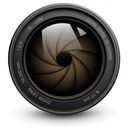
A glimpse into the vastness of the Milky Way

Ilmen Lake illuminated by a sparkling starry sky
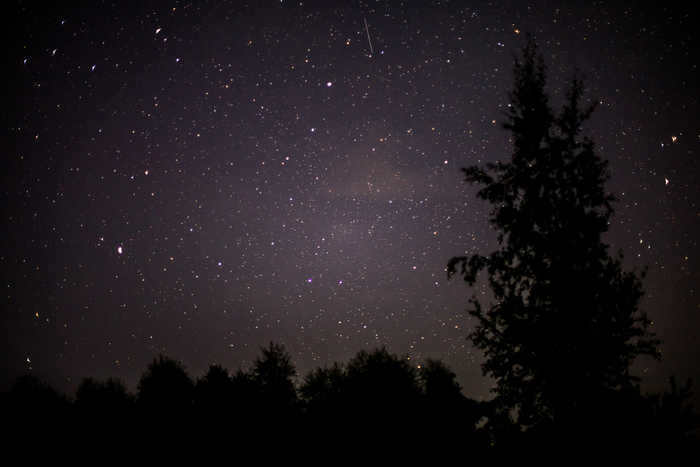
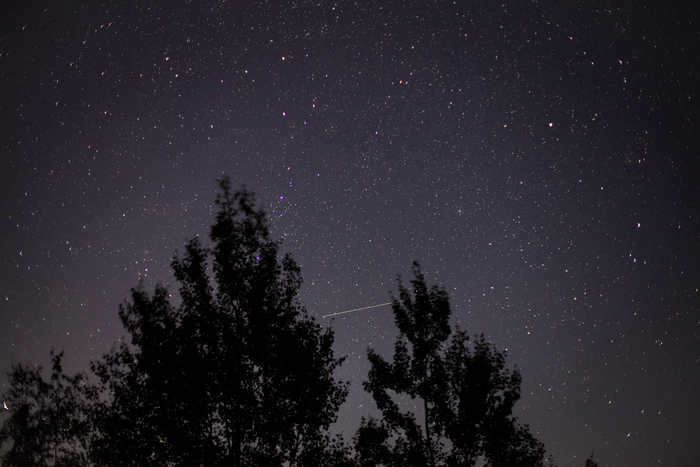
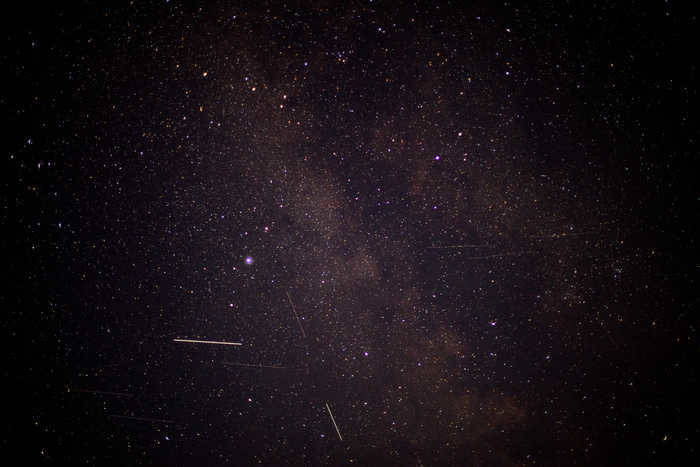
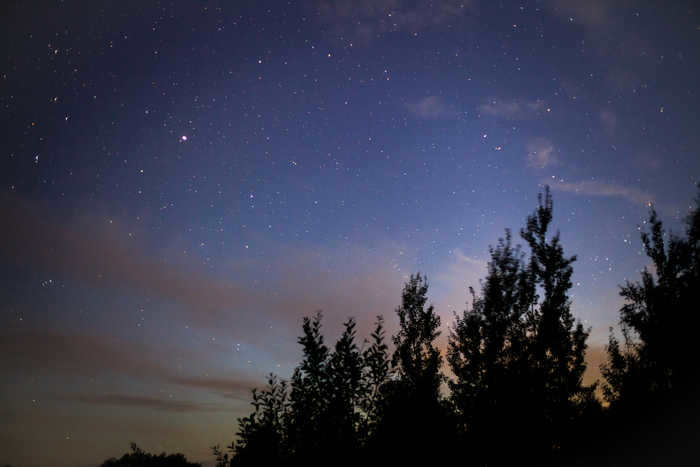
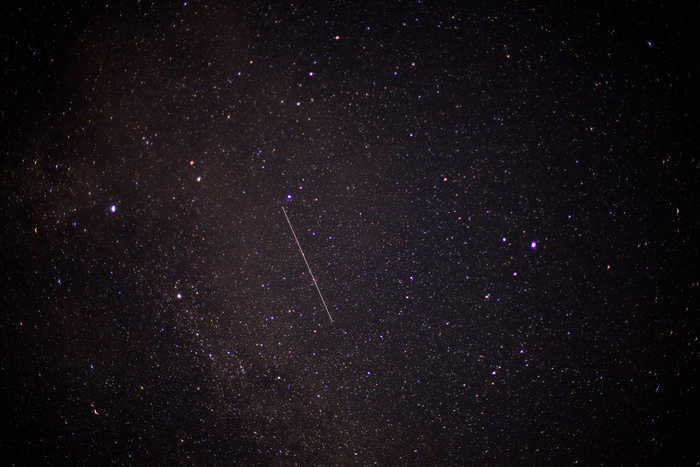

Cassiopeia
The constellation Cassiopeia is located 80 km from Minsk and was captured using a Nikon d80 camera with a Nikkor 50mm 1.8 lens.
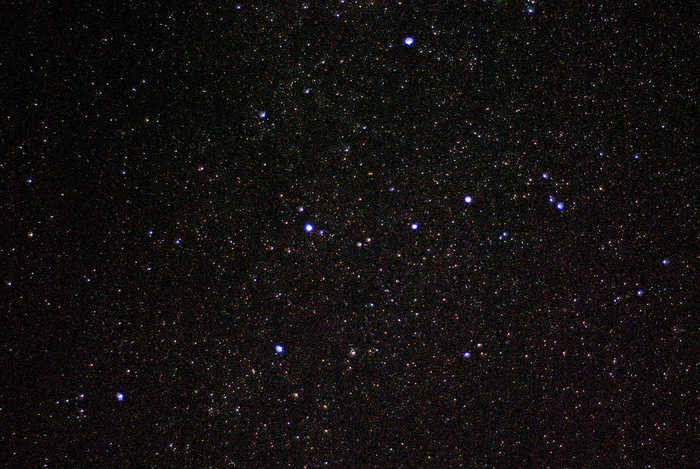

Andromeda Galaxy
My first attempt at photographing the Andromeda Galaxy through a telescope was not successful. Despite using a 30-second exposure, I ended up capturing a dark cloud instead. Frustrated, I decided to take a picture from a tripod with a 50 mm lens, and the results were much clearer. If anyone has experience with astrophotography through a telescope, I would greatly appreciate some advice on how to do it correctly. The telescope I am using is a budget-friendly Celestron 70lt az.
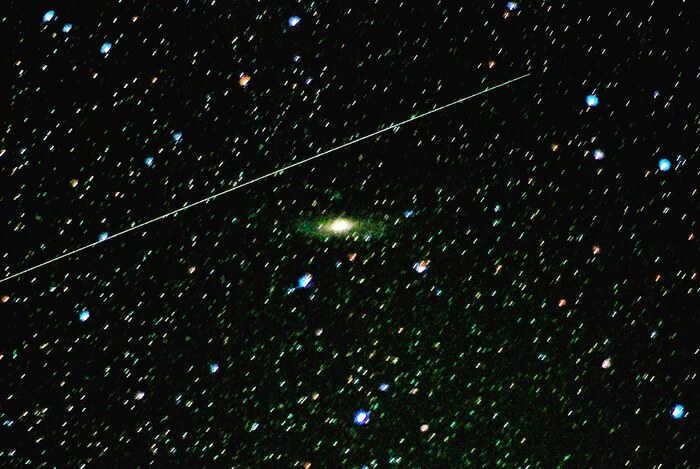
Desirable Properties in Our Solar System
The Soviet Union launched the first artificial satellite in 1957, a fact that is well known to all. Since then, many years have passed and numerous space agencies, private companies, and research institutes have been expanding their presence in the solar system. The extent of their achievements is too vast to list comprehensively. While it may seem that there is ample space for everyone in this expansive realm, certain “real estate” objects are undeniably more alluring than others. One such example is the Lagrange points, which captivate the attention of all interested parties. These points are named after an 18th-century mathematician who determined their location and are highly prized for their unique stability amidst the ever-changing turbulence of our cosmic corner.
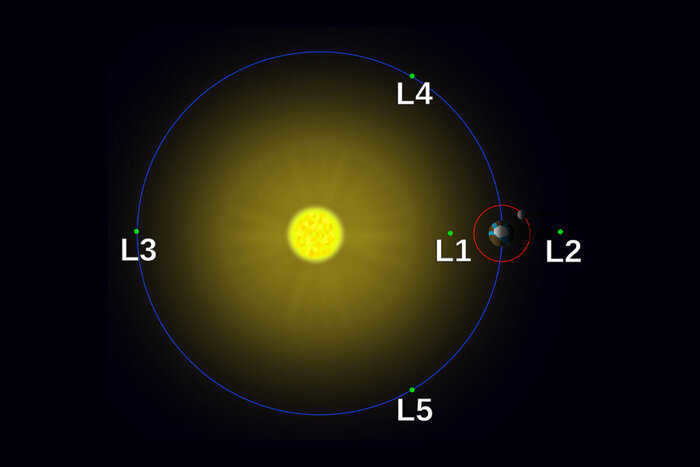
Every celestial body has a gravitational effect on one another. They are particularly sensitive to nearby objects. In these systems, the influence of other forces is also present, which collectively determine the appearance of the orbits of these “participants of motion”. At Lagrangian points, these forces are in equilibrium. Therefore, if you position an object with a relatively small mass there, it will maintain a constant distance from the bodies that create pockets of stability. These areas are metaphorically referred to as cosmic parking lots: once something is in them, the need for energy to remain there practically disappears. Overall, it is an ideal location for any man-made object intended for long-term space habitation.
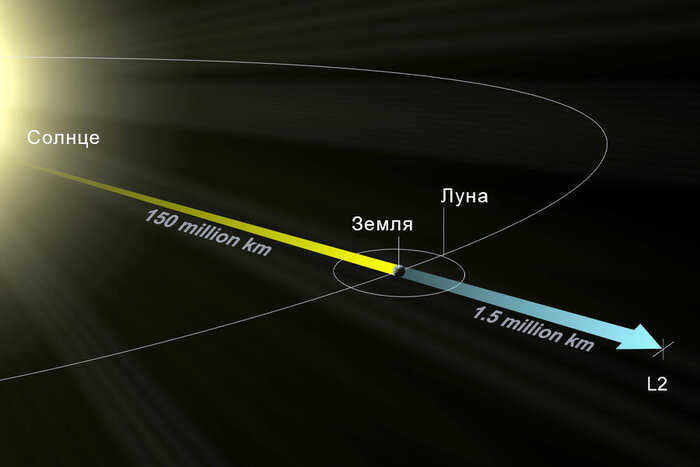
The issue of what can be placed in a specific Lagrangian point is quite fascinating. Let’s focus on those created by the gravitational interaction between the Sun and the Earth. L1 is situated approximately 1.5 million kilometers away from our planet, between these two celestial bodies. Thanks to the unobstructed view of the star, it serves as an optimal location for observing the Sun.
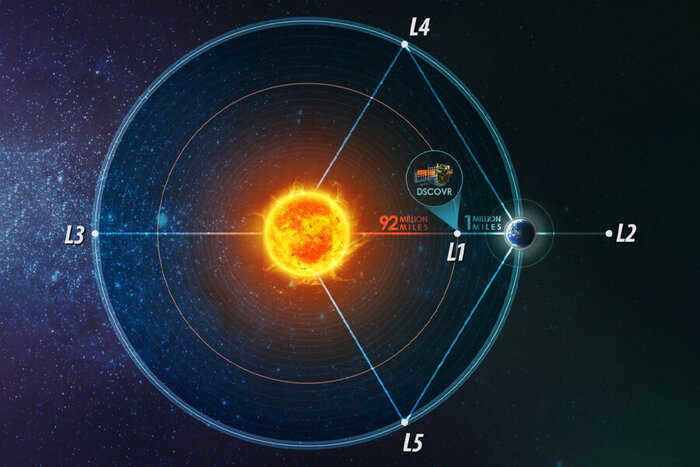
The Deep Space Climate Observatory is an American spacecraft situated at Lagrangian point 1 that is dedicated to observing the Sun and Earth.
L2 is positioned on the opposite side of Earth and at an equal distance. This location ensures that it is effectively shielded from direct sunlight, allowing for unparalleled opportunities to observe the vastness of space. In 2022, the highly anticipated James Webb telescope, which astronomers have eagerly awaited for two decades, commenced its mission from this vantage point.
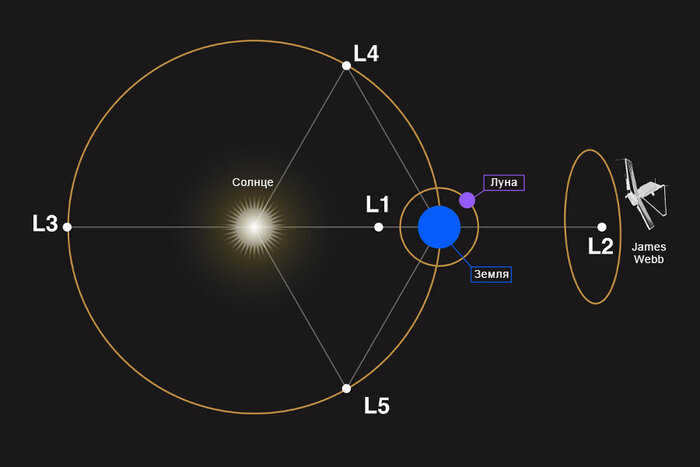
L3 is located in the most enigmatic region, precisely on the opposite side of Earth’s orbit from the Sun. This unique spot in the universe remains completely hidden from the view of any planet’s surface, making it an intriguing subject for science fiction enthusiasts. However, from a scientific standpoint, L3 holds minimal significance.
L4 and L5 exhibit some differences compared to the previous Lagrangian points. The distinguishing factor is that the initial three points in each Lagrangian set demonstrate a slight instability, causing objects within them to gradually shift sideways. While it is possible to maintain their position here, it does require additional effort. In certain pairs of celestial bodies, such as those with a mass ratio of less than 25, the stability of L4 and L5 may not be particularly high. However, in the case of the Sun-Earth system, where the star is significantly more massive than the planet, these points exhibit remarkable stability. Furthermore, they appear to attract a variety of objects, with the most notable example being the accumulation of thousands of asteroids at L4 and L5 in the Sun-Jupiter system.
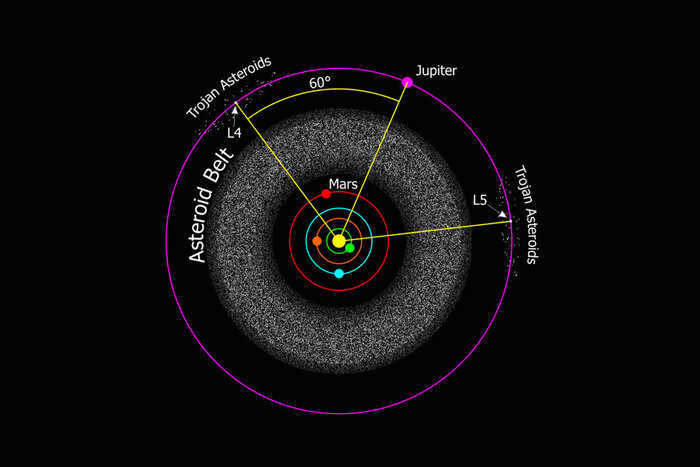
Each Lagrangian point within our solar system possesses unique characteristics. Some of these points offer the potential for gathering building materials, envisioning them as drifting asteroids. Other points could serve as locations for refueling stations, providing fuel for spacecraft embarking on deep space journeys. It is even possible that these points could support human colonies, suspended in space. These possibilities, however, lie within the distant future, a future we may not witness given the current state of affairs on our planet. Nonetheless, it is pleasant to indulge in such dreams, isn’t it?
We deeply value all of our readers. If you wish to provide us with financial support (by using the button provided below), your name or nickname will be acknowledged in our upcoming publication. This is our modest way of expressing our gratitude for your generosity and encouragement!
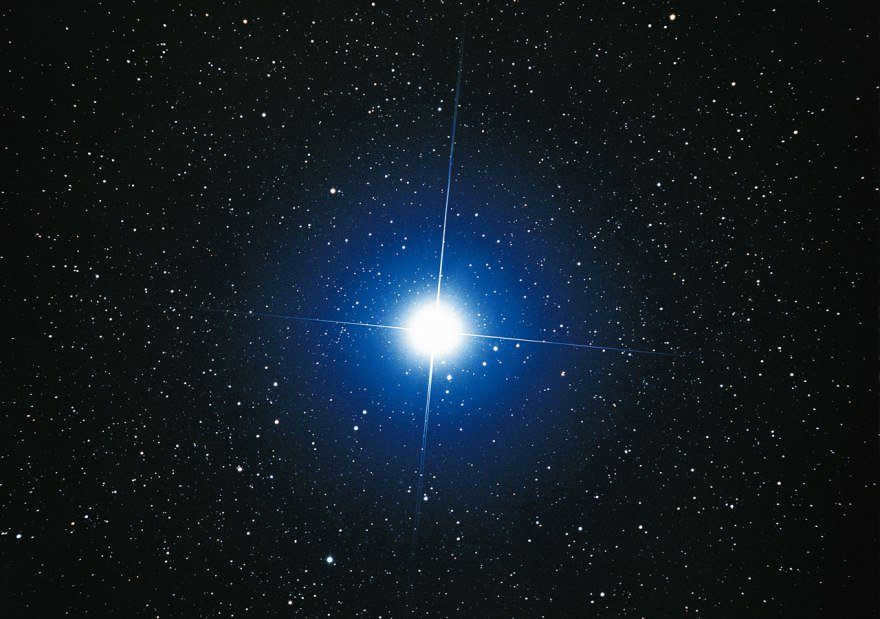
For individuals residing south of 83 degrees north latitude, Sirius stands out as the most brilliant star in the observable cosmos. With a 1st sidereal magnitude, it ranks as the fifth most luminous celestial entity. However, was it perpetually the most radiant star?
The most brilliant celestial body in existence today
Undoubtedly, Sirius takes the top spot in terms of luminosity. This particular star is located 8.6 light-years away and held great significance for the ancient Egyptians, who established their calendar based on its movements.
Fascinatingly: Arcturus claims the title of the brightest star situated north of the celestial equator, boasting an impressive magnitude of -0.04.
Furthermore, let us not forget about Vega, which held the esteemed position of being the brightest star in the night sky approximately 200,000 years ago.
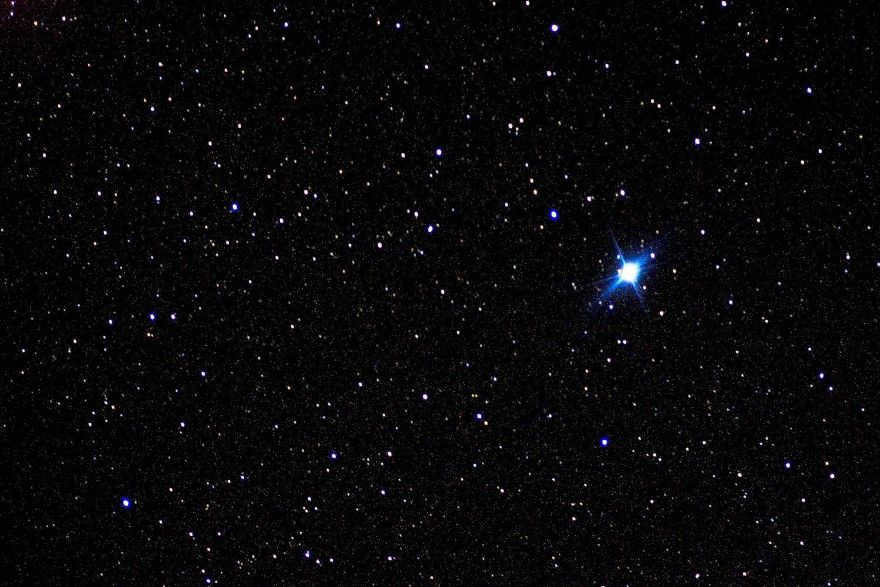

Canopus dominated the night sky in 90000 BC.
What causes changes in the brightness hierarchy of celestial objects? The answer lies in constant motion. Our solar system is traveling through the Milky Way at a speed of 250 kilometers per second. It takes 250 million years to complete one orbit. This means that in the 4.5 billion years of the Solar System’s existence, we have completed only 18 galactic orbits.
In addition, the solar system also oscillates up and down about the galactic plane. This process takes another 93 million years. The stars are also moving along with us. In the video, you can observe the motion of stars in the Big Dipper constellation.
The variations in brightness are known as apparent magnitude. This measurement is dependent on the observer’s location on Earth. To obtain a more precise measurement, scientists use absolute magnitude, which is the brightness of a star at a distance of 10 parsecs. If Deneb were placed at this distance, its magnitude would be -8.4. Let’s analyze the roster of the most luminous stars in the sky from the viewpoint of an observer on Earth.
Compilation of the most brilliant celestial bodies in the observable Universe as seen from the planet Earth
| 0 | The Sun | 0.0000158 | -26.72 | 4.8 | G2V | |
| 1 | Sirius (α Canis Majoris) | 8.6 | -1.46 | 1.4 | A1Vm | Southern hemisphere |
| 2 | Canopus (α Carinae) | 310 | -0.72 | -5.53 | A9II | South |
| 3 | Rigil Kentaurus (α Centauri) | 4.3 | -0.27 | 4.06 | G2V+K1V | South |
| 4 | Arcturus (α Bootis) | 34 | -0.04 | -0.3 | K1.5IIIp | North |
| 5 | Vega (α Lyrae) | 25 | 0.03 (permanent) | 0.6 | A0Va | North |
| 6 | Capella (α Aurigae) | 41 | 0.08 | -0.5 | G6III + G2III | North |
| 7 | Rigel (β Orionis) | ~870 | 0.12 (permanent) | -7 [3] | B8Iae | South |
| 8 | Procyon (α Canis Minoris) | 11.4 | 0.38 | 2.6 | F5IV-V | North |
| 9 | Achernar (α Eridani) | 69 | 0.46 | -1.3 | B3Vnp | South |
| 10 | Betelgeuse (α Orionis) | ~530 | 0.50 (permanent) | -5.14 | M2Iab | North |
| 11 | Hadar (β Centauri) | ~400 | 0.61 (permanent) | -4.4 | B1III | South |
| 12 | Altair (α Aquilae) | 16 | 0.77 | 2.3 | A7Vn | North |
| 13 | Acrux (α Crucis) | ~330 | 0.79 | -4.6 | B0.5Iv + B1Vn | South |
| 14 | Aldebaran (α Tauri) | 60 | 0.85 (removable) | -0.3 | K5III | North |
| 15 | Antares (α Scorpii) | ~610 | 0.96 (permanent) | -5.2 | M1.5Iab | South |
| 16 | Spica (α Virginis) | 250 | 0.98 (permanent) | -3.2 | B1V | Southern hemisphere |
| 17 | Pollux (β Geminorum) | 40 | 1.14 | 0.7 | K0IIIb | Northern hemisphere |
| 18 | Fomalhaut (α Piscis Austrini) | 22 | 1.16 | 2.0 | A3Va | Southern hemisphere |
| 19 | Mimosa (β Crucis) | ~290 | 1.25 (permanent) | -4.7 | B0.5III | Southern hemisphere |
| 20 | Deneb (α Cygni) | ~1550 | 1.25 | -7.2 | A2Ia | Northern hemisphere |
| 21 | Regulus (α Leonis) | 69 | 1.35 | -0.3 | B7Vn | Northern hemisphere |
| 22 | Adhara (ε Canis Majoris) | ~400 | 1.50 | -4.8 | B2II | South |
| 23 | Castor (α Geminorum) | 49 | 1.57 | 0.5 | A1V + A2V | Northern hemisphere |
| 24 | Hadar (γ Crucis) | 120 | 1.63 (permanent) | -1.2 | M3.5III | South |
| 25 | Shaula (λ Scorpii) | 330 | 1.63 (permanent) | -3.5 | B1.5IV | Southern hemisphere |
From the perspective of human life, every star and constellation appears identical. They simply do not have enough time to undergo noticeable changes within an 80-100 year span. However, if one were to live for centuries, they would observe a gradual shift known as proper motion. For instance, Barnard’s Star and 61 Swans exhibit a proper motion of 10 and 3.2 arc seconds per year, respectively. It is important to note that proper motion measures the speed relative to our line of sight.
The most dazzling star in the cosmos in ancient times
The secrets of dominance in bygone eras are unveiled through radial movement. As the distance increases, the light diminishes in accordance with the inverse square law. Imagine taking a lit candle and gradually moving it farther away. Although the light remains the same, it appears less radiant to the observer.
Presently, we are journeying towards the solar apex near the star Omicron Hercules at a velocity of 16.5 kilometers per second. However, it is conceivable to retrace our steps. For instance, the magnitude of Delta Shield 2.4 would elevate to -1.8, surpassing the brilliance of contemporary Sirius. Additionally, 4.7 million years B.C., the star Adara achieved a magnitude of -4 instead of its current 1.5.
Arcturus is currently hurtling through our galactic vicinity at a rate of 2 arc seconds per year. It is currently at its zenith of luminosity (a process spanning 4000 years) and will gradually begin to fade from sight.
The future holds the promise of Albireo becoming the most brilliant star in the Universe
Prepare yourself for the awe-inspiring moment when Albireo closes the gap by 300 light-years and shines with a magnitude of -0.5. This monumental event will provide future scientists with the opportunity to ascertain whether Albireo is truly a binary star system or not.
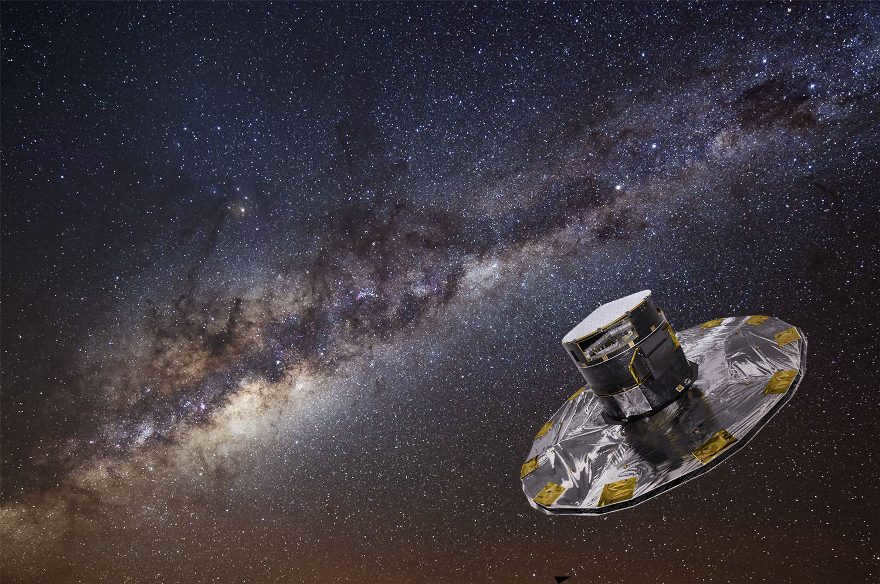
An artistic interpretation of the search conducted by the Gaia telescope
How do we go about determining the brightness of stars? Modern missions such as Hipparcos have utilized parallax and proper motion measurements to achieve this. This method is a significant improvement over previous attempts that relied on a stopwatch and a wire.
This research has aided in the identification of the faintest cinnamon and red dwarfs. Furthermore, Gaia will provide an unprecedented level of accuracy. It’s important to note that the term “brightest” does not necessarily mean “closest.” As an example, a red Scholz dwarf was recently discovered, which, despite its proximity, has a magnitude of 7 and therefore cannot be considered particularly bright.
In 300,000 years, HIP 85605 will come within 0.5 light-years of us and will have a brightness of -2. The gamma-ray emitted by Microscope, which was 4.7 magnitudes bright, passed by the Sun 6 light-years away 3.8 million years ago and will have a brightness of -3.
